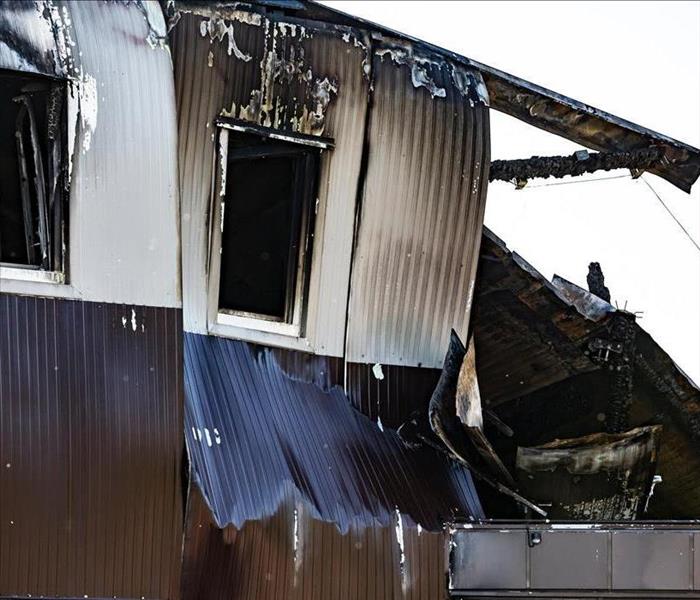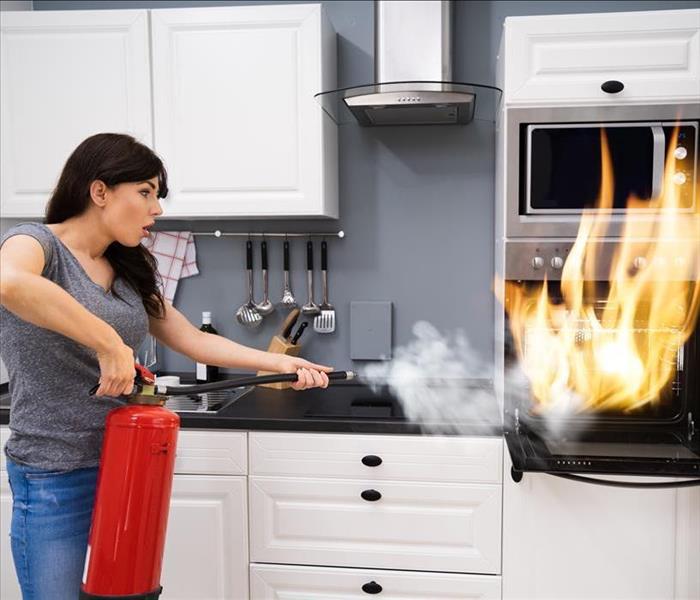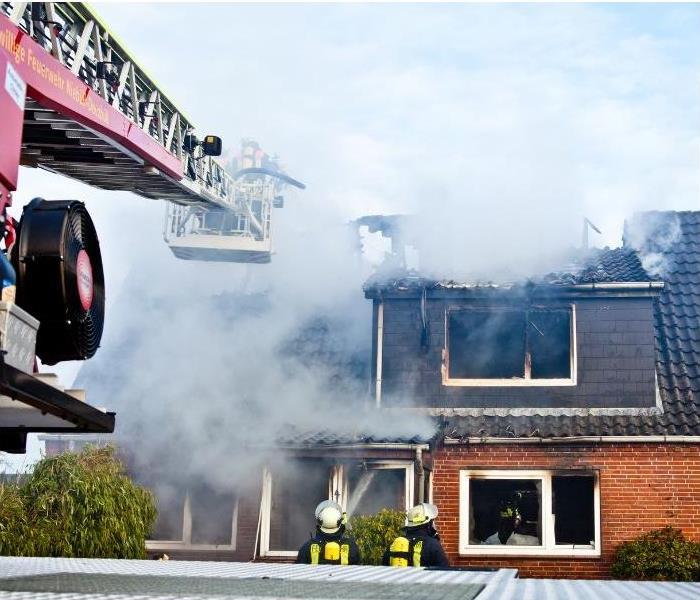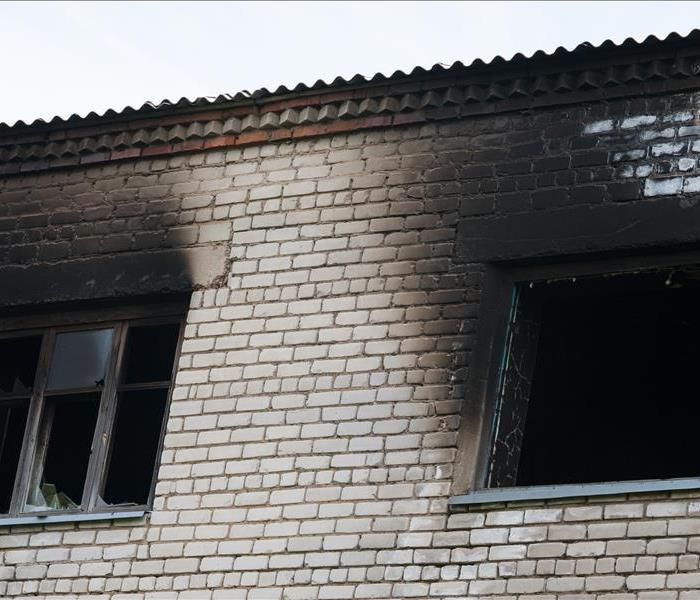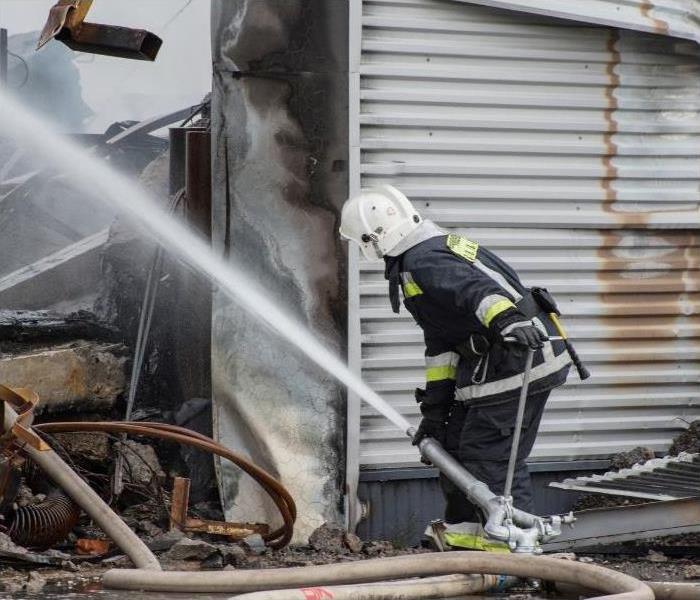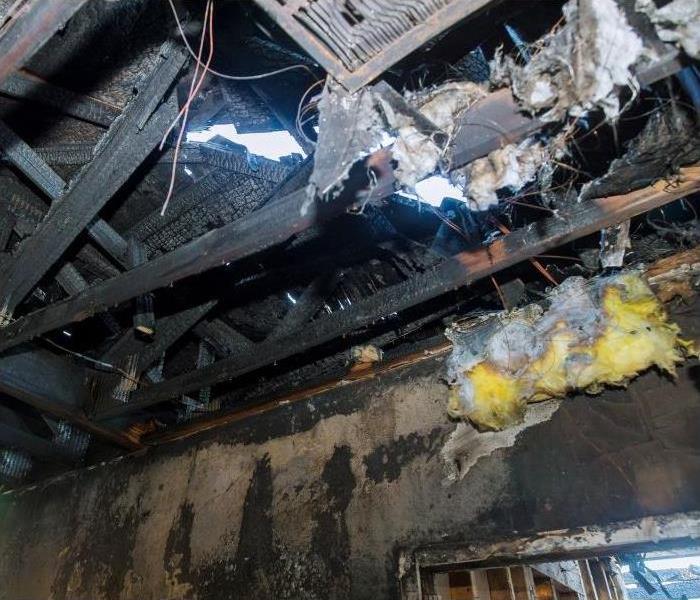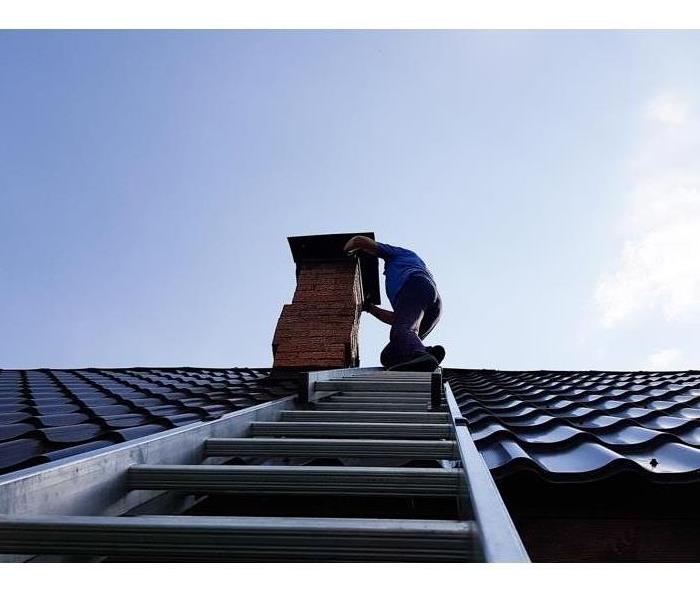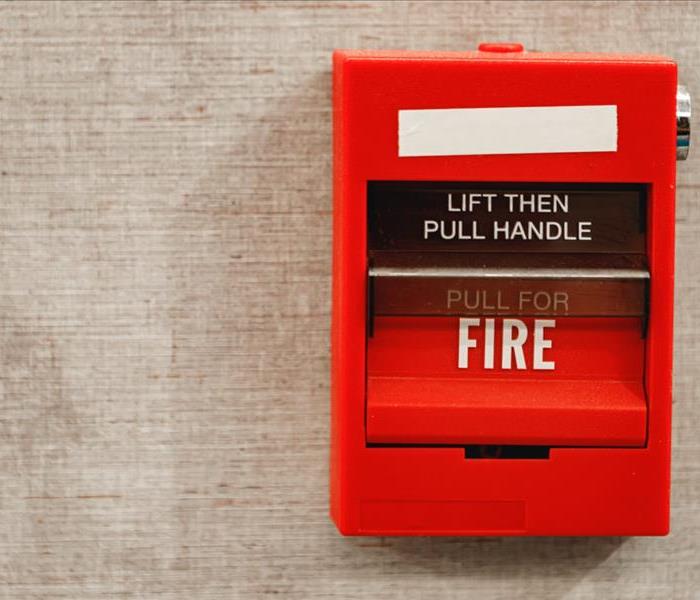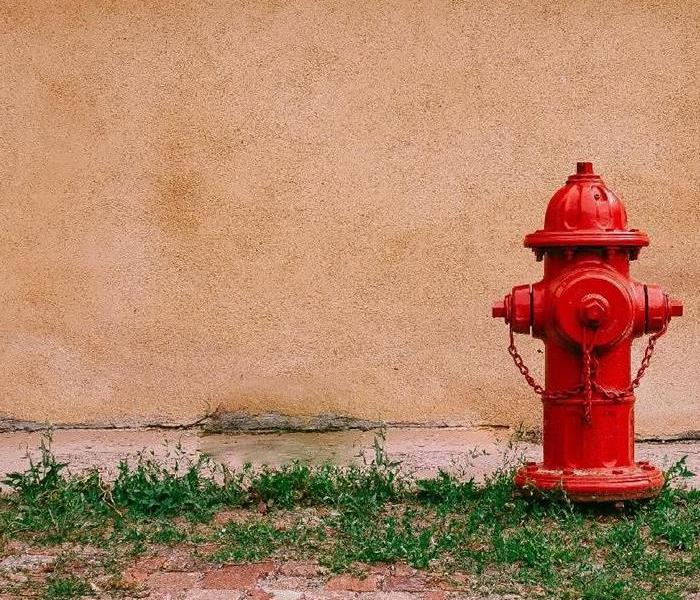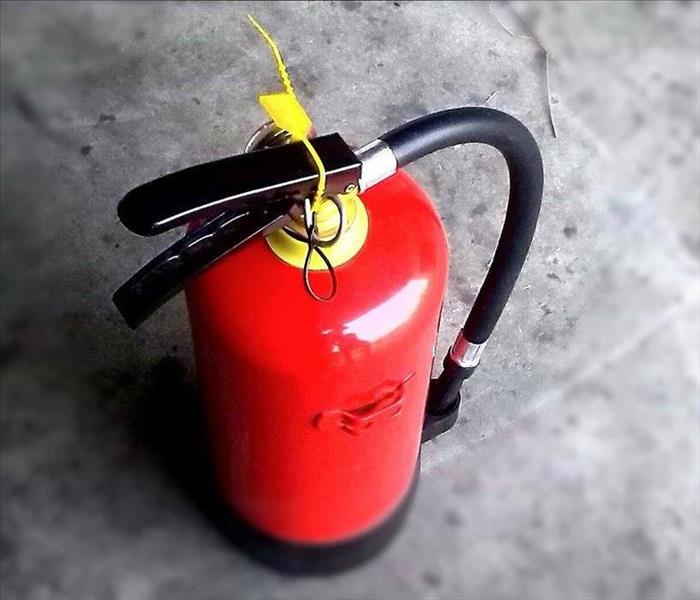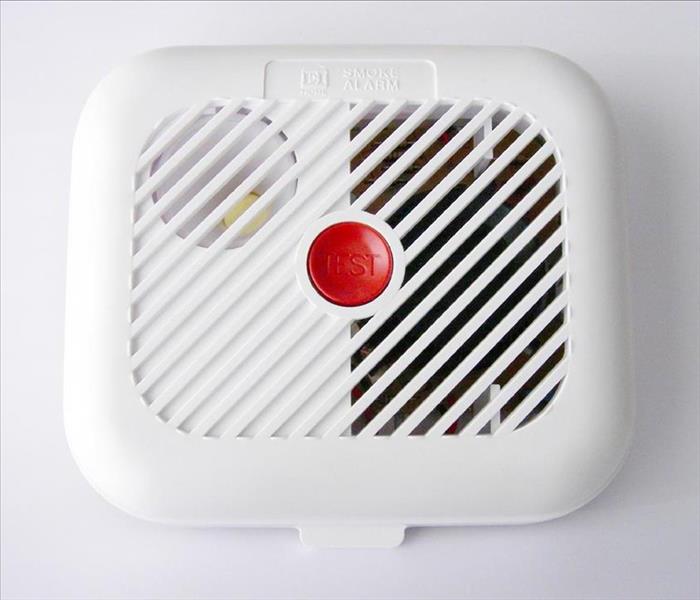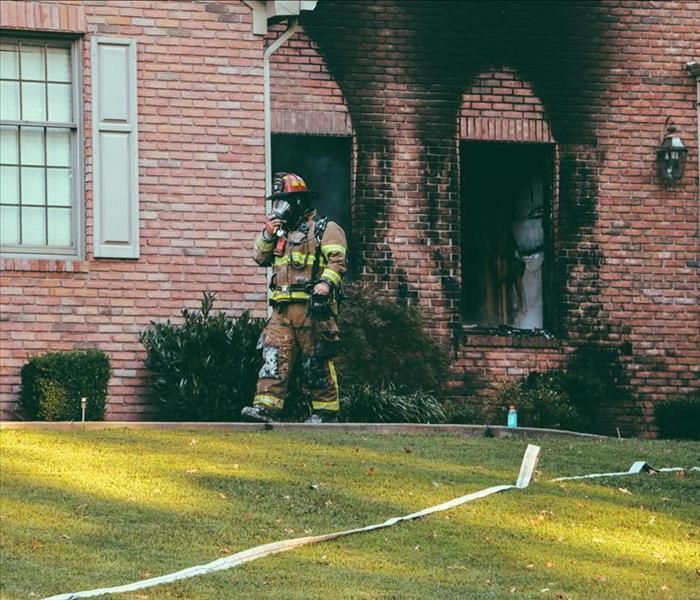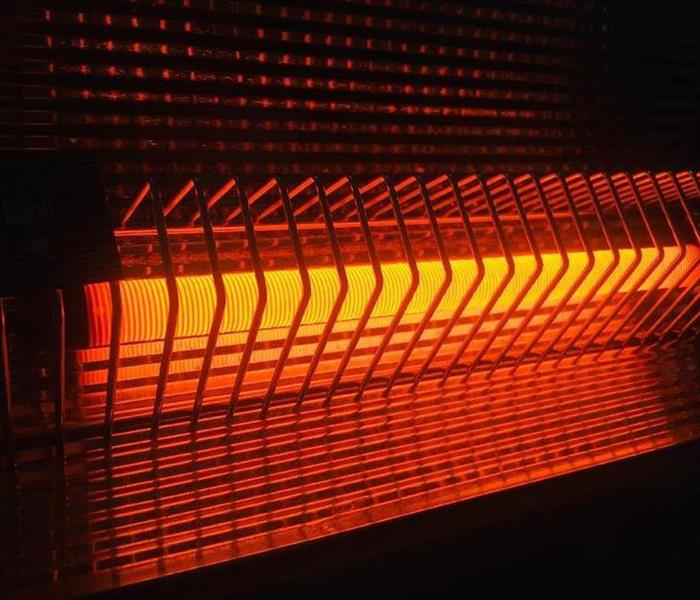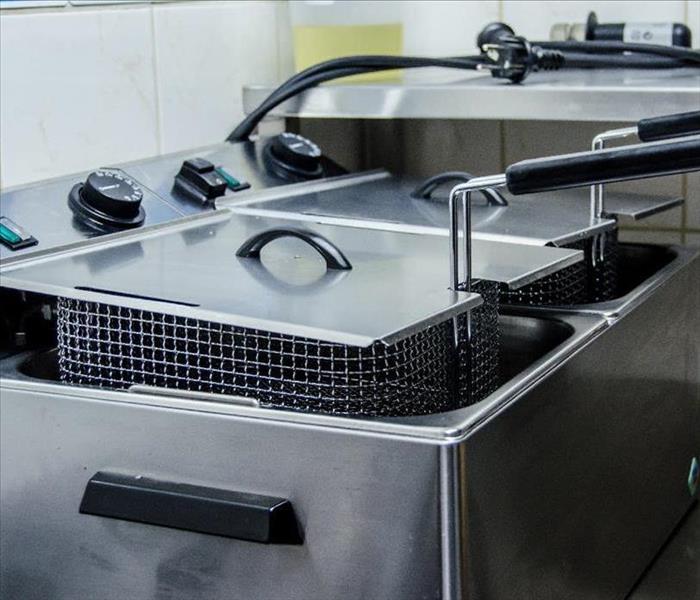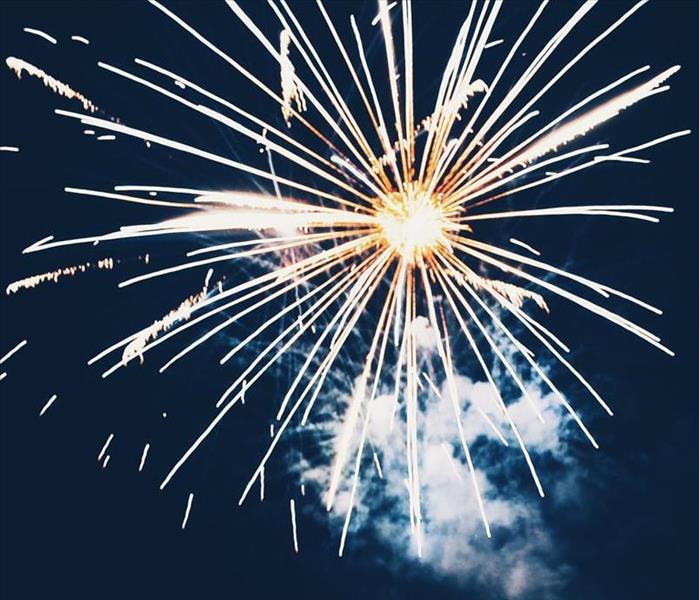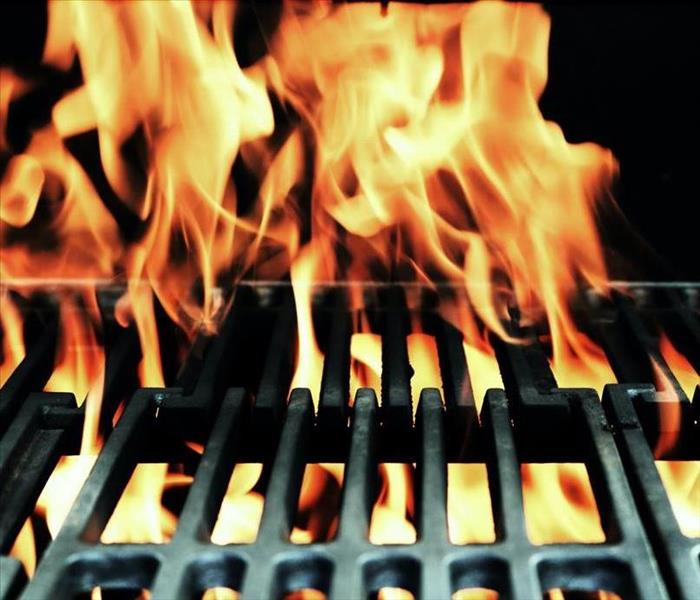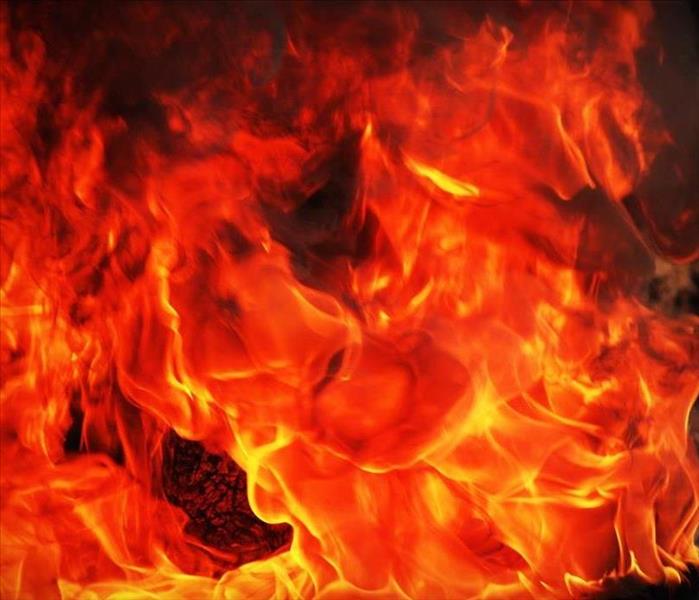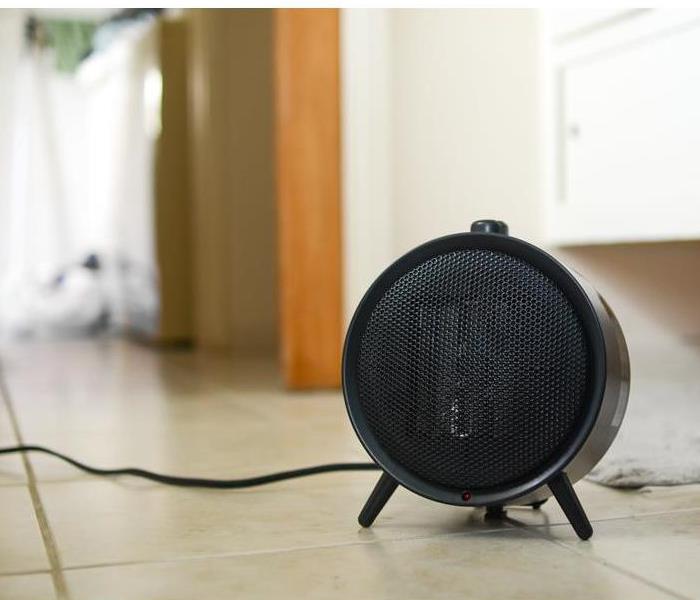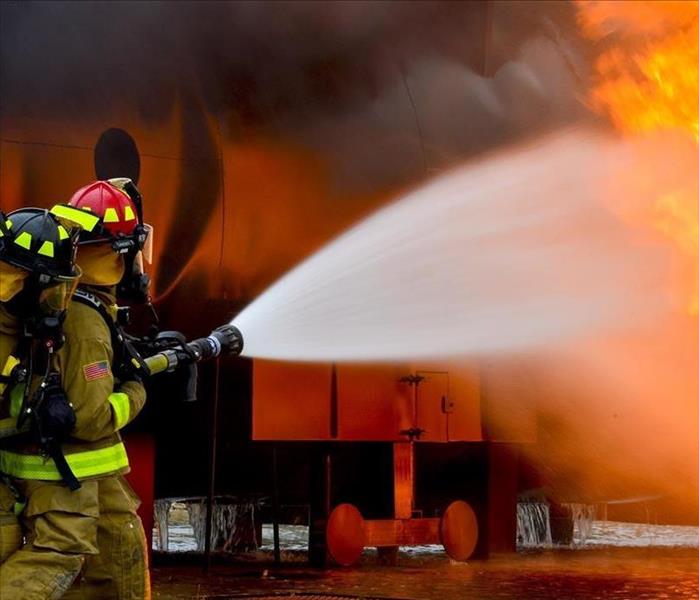Archived Fire Damage Blog Posts
What to Look for in Commercial Fire Damage Restoration?
7/11/2024 (Permalink)
In commercial fire damage restoration, seek expertise, emergency response, thorough damage assessment, advanced technology, insurance help, and client satisfaction. Look for experienced professionals who respond swiftly to emergencies, thoroughly evaluate all damage, and use cutting-edge equipment to guarantee meticulous restoration. Assistance with insurance claims and a focus on customer satisfaction is essential for a stress-free process. Prioritize industry experience, trained technicians, and detailed planning for successful recovery. Choosing the right restoration team is pivotal for the efficient and effective restoration of your commercial space.
Key Takeaways
- Seek expertise from certified technicians for quality restoration work.
- Prioritize companies with 24/7 emergency response capabilities.
- Choose providers with advanced equipment and cutting-edge techniques.
- Opt for assistance in navigating insurance claims for financial benefits.
- Focus on customer satisfaction through quality assurance practices.
Industry Experience Matters
When selecting a commercial fire damage restoration company, keep in mind that industry experience matters greatly in ensuring a successful and efficient restoration process. Expert knowledge and a proven track record are essential in guiding the complexities of commercial fire damage restoration. A company with extensive experience will have encountered a wide range of scenarios, allowing them to approach your specific situation with confidence and expertise.
Expert knowledge is the cornerstone of effective fire damage restoration. An experienced company will have a deep understanding of the science behind fire damage, including how the smoke travels, the different types of damage that can occur, and the best techniques for restoring various materials. This expertise enables them to develop a thorough restoration plan tailored to your unique needs, ensuring that no detail is overlooked.
Furthermore, a proven track record speaks volumes about a company's reliability and quality of service. By choosing a restoration company with a history of successful projects, you can have confidence in their ability to deliver results. Look for testimonials, case studies, and examples of past work to gauge the company's reputation and track record.
24/7 Emergency Response Capability
When evaluating a commercial fire damage restoration company's capabilities, examining its emergency response capability is vital for ensuring fast and effective mitigation of damages. Rapid response is a key component of a reliable fire damage restoration service. A company that offers emergency services with a quick turnaround time can help minimize the extent of damage to your commercial property.
In times of crisis, having a restoration company that can swiftly deploy a team to assess the situation and start the restoration process is invaluable. Look for a company that has a well-established emergency response protocol in place, ensuring that they can mobilize resources promptly to address your fire damage restoration needs.
Effective emergency services entail more than just showing up quickly; it also involves having the expertise to handle the situation competently. A reputable commercial fire damage restoration company will have trained professionals who know how to assess the damage, prioritize actions, and execute restoration efforts efficiently.
Certified and Licensed Technicians
As your focus shifts to the importance of having certified and licensed technicians for commercial fire damage restoration, the expertise and qualifications of the professionals handling the restoration process become paramount. When selecting a restoration company, make sure they've certified technicians who've undergone rigorous training to handle the complexities of commercial fire damage restoration. Here's why this is vital:
- Peace of Mind: Knowing that certified technicians are working on restoring your commercial property can provide you with a sense of security during a stressful time. Their training equips them with the necessary skills to tackle fire damage efficiently, giving them peace of mind.
- Quality Assurance: Licensed technicians adhere to specific standards and regulations set by governing bodies. This ensures that the restoration process is carried out correctly and to the highest standards, guaranteeing quality workmanship throughout.
- Expertise and Efficiency: Technicians who've completed the required training and meet licensing requirements are likely to work more efficiently due to their expertise. Their knowledge allows them to assess the damage accurately, develop effective restoration plans, and execute them proficiently, minimizing downtime for your business.
Having certified and licensed technicians handle your commercial fire damage restoration not only ensures a job well done but also instills confidence that your property is in capable hands.
Comprehensive Damage Assessment
Conducting a thorough and meticulous assessment of the fire damage is essential to developing a precise plan for commercial fire damage restoration. A detailed evaluation involves a thorough inspection of the entire affected area, taking into account visible damage as well as potential hidden issues that may arise later on. This assessment is crucial in understanding the extent of the damage, identifying salvageable items, and determining the best course of action for restoration.
During the detailed inspection, trained technicians will assess the structural integrity of the building, the extent of smoke and soot damage, water damage from firefighting efforts, and the presence of any hazardous materials. By examining each of these aspects carefully, they can create a comprehensive overview of the damage and develop a tailored restoration plan that addresses all the specific needs of the property.
Customized Restoration Plan
Crafting a detailed and tailored plan for commercial fire damage restoration is crucial for effectively addressing all damage and restoring your property efficiently. By thoroughly analyzing the assessment findings, you can identify specific restoration needs and create a customized plan that meets those requirements. Here are three key elements to consider when developing a restoration plan:
- Restoration Timeline: Developing a clear timeline is essential to keep the restoration process on track and minimize downtime for your commercial property. By setting specific milestones and deadlines, you can ensure that the restoration progresses smoothly and in a timely manner. This approach helps you resume normal operations as quickly as possible.
- Budget Constraints: Understanding your budget limitations is crucial for creating a successful restoration plan. By knowing the financial resources available for the project, you can prioritize tasks, allocate funds effectively, and avoid unnecessary expenses. This budget-conscious approach ensures that you stay within your financial limits while achieving comprehensive fire damage restoration.
- Tailored Restoration Approach: Every commercial property has unique characteristics and damage. Tailoring the restoration approach to address the specific requirements of your property is key to a successful restoration process. A customized plan ensures that the restoration is targeted and effective, leading to a more satisfactory outcome. By adapting the restoration plan to your property's needs, you show care and commitment to your business space, enhancing its overall restoration outcome.
Advanced Equipment and Techniques
Utilize state-of-the-art equipment and specialized techniques to enhance the efficiency and effectiveness of the commercial fire damage restoration process. When selecting a commercial fire damage restoration service, make sure they utilize the latest cutting-edge technology and have staff with specialized training in using this equipment. Advanced equipment such as thermal cameras, dehumidifiers, ozone generators, and industrial-grade cleaning agents can greatly expedite the restoration process.
Innovative solutions and efficient processes are vital to restoring your commercial property promptly. Seek restoration companies that invest in cutting-edge equipment like air scrubbers to eliminate smoke odors, dry ice blasting for soot removal, and moisture meters to detect hidden water damage. These tools allow for a more thorough restoration, ensuring that all traces of fire damage are addressed.
Specialized training in handling these advanced tools is essential to achieving successful restoration outcomes. Restoration technicians should be well-versed in the latest techniques to mitigate fire damage effectively. By entrusting your commercial property to experts with access to advanced technology and specialized training, you can feel confident that the restoration process will be executed with precision and care.
Insurance Claim Assistance
Seeking professional assistance with your insurance claim after a commercial fire can streamline the restoration process and guarantee a smoother experience. When managing the claim process and understanding your policy coverage, having experts by your side can make a significant difference.
Here are three key ways insurance claim assistance can benefit you:
- Expert Guidance: Dealing with insurance companies can be intricate and overwhelming. Insurance claim professionals have the knowledge and experience to guide you through the complexities of the claim process, ensuring you comprehend your rights and entitlements under your policy coverage.
- Maximized Coverage: Insurance policies contain subtleties that may impact the extent of coverage you receive. With the help of professionals, you can make sure that you maximize your policy coverage, potentially leading to a better financial outcome for your restoration needs.
- Efficient Process: By enlisting the help of experts for your insurance claim, you can expedite the process and avoid unnecessary delays. Their expertise in handling paperwork, negotiations, and communication with the insurance company can save you time and energy, allowing you to focus on the restoration of your commercial property.
Customer Satisfaction Guarantee
To guarantee customer satisfaction, our restoration company pledges a seamless and high-quality experience throughout the fire damage restoration process. We recognize the importance of making sure that our customers feel valued and supported during what can be a challenging time. To assess and uphold our dedication to customer satisfaction, we've implemented a thorough assurance evaluation system. This system allows us to continuously monitor and improve our services based on satisfaction measurement metrics.
Our assurance evaluation process involves gathering feedback from customers at key touchpoints during the restoration process. By actively seeking input from our clients, we can identify areas where we excel and areas where we can enhance our services further. Additionally, we conduct thorough satisfaction measurements upon the completion of the restoration project to ensure that every aspect of our work meets or exceeds customer expectations.
At our restoration company, customer satisfaction isn't just a goal; it's a standard that guides everything we do. We believe that by prioritizing the needs and feedback of our customers, we can deliver exceptional service that fosters long-term relationships built on trust and reliability. Our dedication to assurance evaluation and satisfaction measurement underscores our commitment to providing a positive and supportive experience for every client we serve.
Wrap-Up
When dealing with commercial fire damage restoration, it's important to choose a company with industry experience, 24/7 emergency response capabilities, certified technicians, and advanced equipment.
A thorough damage assessment and customized restoration plan are vital for a successful recovery. Look for a company that offers insurance claim assistance and a customer satisfaction guarantee to ensure peace of mind throughout the restoration process.
Trusting in a reputable restoration company will help you get your business back on track efficiently and effectively.
5 Tips for Fast Fire Damage Cleanup
6/11/2024 (Permalink)
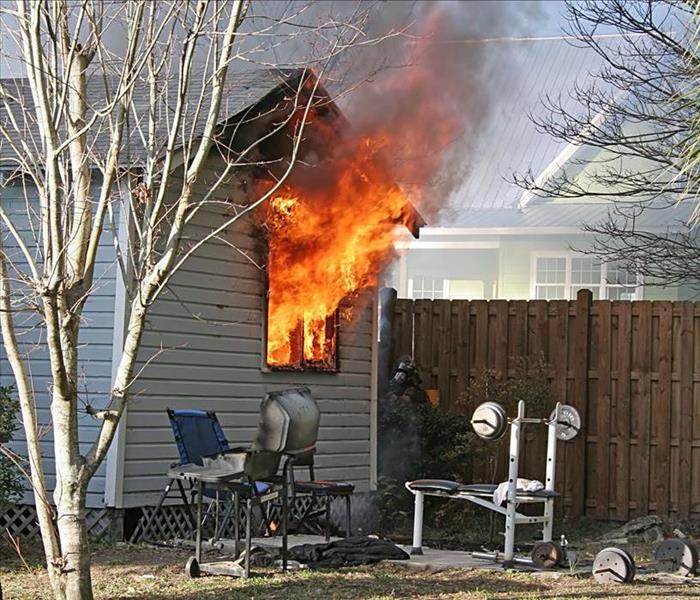 5 Tips for Fast Fire Damage Cleanup
5 Tips for Fast Fire Damage Cleanup
When dealing with fire damage, swiftly assess the extent of safety. Clean soot efficiently using proper methods to prevent more damage. Dispose of debris strategically, following local regulations. Eliminate odors promptly by identifying sources and cleaning thoroughly. Seek restoration experts for quick action and thorough restoration. Mastering these tips will streamline your fire damage cleanup, aiding in a swift and efficient property recovery.
Key Takeaways- Swiftly evaluate the extent of fire damage and ensure safety.
- Prioritize thorough soot removal techniques to prevent further damage.
- Categorize debris for efficient disposal following local regulations.
- Quickly eliminate lingering odors using proper techniques.
- Contact restoration professionals promptly for timely property restoration.
Rapid AssessmentBegin by swiftly evaluating the extent of the fire damage to determine the immediate steps needed for cleanup. When facing a fire emergency, prompt action is vital. Your first priority is ensuring everyone's safety, so make sure all individuals are out of harm's way before proceeding with the assessment. Once emergency response teams have deemed it safe to enter the premises, assess the damage with a trained eye. Look for visible signs of destruction, including charred materials, smoke residue, and water damage from firefighting efforts. Take note of any structural issues that may compromise the safety of the cleanup process.
Damage evaluation is a critical aspect of the cleanup process. Thoroughly inspecting the affected areas can help you prioritize tasks and allocate resources efficiently. Document the extent of the damage through photographs or written notes to aid in insurance claims and restoration efforts. Identify salvageable items and materials that can be cleaned and restored, as well as those that must be disposed of properly. Remember that some damage may not be immediately visible, so the expertise of professionals is required for a thorough assessment.
It's natural to feel overwhelmed in times of crisis, but remember that you're not alone. Seek support from family, friends, or professional cleanup services to navigate this challenging situation. By taking swift and decisive action in your emergency response and damage evaluation, you're laying the foundation for a successful cleanup process.
Efficient Soot RemovalTo efficiently remove soot after a fire, prioritize thorough cleaning techniques to restore your property effectively. Soot removal is a vital step in the fire damage cleanup process, and using the right techniques is essential for a successful restoration. When dealing with soot, it's important to act quickly to prevent it from causing further damage to your belongings and property.
There are various soot removal techniques you can use to tackle the aftermath of a fire. One effective method is dry cleaning, where specialized sponges and vacuums are used to remove loose soot from surfaces. Wet cleaning is another option that involves using water or cleaning solutions to wipe down surfaces and remove stubborn soot stains. For delicate items, professional cleaning methods may be necessary to guarantee they're properly restored without causing damage.
Professional cleaning methods can be particularly helpful when dealing with extensive soot damage. Fire damage restoration experts have the knowledge, experience, and equipment to effectively remove soot from different surfaces in your home. They can also help assess the extent of the damage and create a customized cleaning plan to address the specific needs of your property.
Strategic Debris DisposalImplementing strategic debris disposal is essential to guarantee a thorough restoration process when managing fire damage cleanup. Proper debris management is key in ensuring that all remnants of the fire are effectively removed, allowing for a fresh start in the restoration of your home. To achieve this, employing efficient disposal techniques is pivotal.
Debris management begins with categorizing the different types of debris present after a fire. Sorting materials into categories such as hazardous, professional, and non-salvageable items can help streamline the delicate items. Restoration is proper, and waste should be handled with caution and disposed of following local regulations to prevent environmental harm.
Once the debris is categorized, utilizing appropriate disposal techniques is crucial. Hiring professional cleanup services can ensure that debris is removed safely and efficiently. These experts have the knowledge and equipment to handle debris disposal properly, preventing any further damage to your property.
Incorporating recycling and donation options for salvageable items can also be a sustainable way to manage debris. By reducing waste and giving back to the community, you contribute to a more environmentally friendly cleanup process.
Quick Odor EliminationTo swiftly tackle lingering odors post-fire, efficient odor elimination is key in completing the thorough cleanup process. Odors from a fire can permeate your home, causing discomfort and reminders of the traumatic event. Quick response is essential to prevent these odors from settling in and becoming harder to remove.
Odor neutralization is an important step in the cleanup process, as it goes beyond just masking the smell with air fresheners. It involves identifying the source of the odor and using appropriate techniques to eliminate it. One effective method is using ozone generators, which release ozone to break down odors at a molecular level. This can be particularly useful for stubborn smoke odors that seem to linger.
In addition to using professional equipment, proper ventilation is crucial to speeding up the odor-elimination process. Opening windows and using fans can help circulate fresh air and remove lingering smells. It's also important to clean all surfaces thoroughly to remove any residue contributing to the odors.
Timely Restoration ProcessesFor efficient and timely restoration processes after a fire, prioritizing swift action and thorough assessment is vital. When facing fire damage, prompt emergency response is essential. Contacting restoration professionals immediately guarantees that they can swiftly assess the extent of the damage and begin the restoration process promptly. These experts are equipped with the necessary restoration techniques to effectively address fire damage, from soot and ash removal to repairing structural damage.
Emergency response teams are trained to handle fire damage efficiently, utilizing advanced equipment and techniques to restore your property as quickly as possible. By entrusting the restoration process to these professionals, you can have peace of mind knowing that they'll work diligently to bring your home back to its pre-fire condition.
During restoration, professionals will work methodically to clean, sanitize, and repair the affected areas. They'll also eliminate any lingering odors, completing the restoration with thoroughness and precision. By following their proven restoration techniques, you can expedite the recovery process and minimize the disruption caused by the fire.
Wrap-UpFollowing these five tips for fast fire damage cleanup, you can efficiently restore your property and get your life back on track.
Remember to assess the damage quickly, remove soot efficiently, dispose of debris strategically, eliminate odors promptly, and initiate restoration processes in a timely manner.
With these steps, you can navigate the cleanup process with ease and minimize the impact of fire damage on your home.
Stay proactive and take action to restore your space as soon as possible.
Top 10 Fire Damage Cleanup Tips for You
5/26/2024 (Permalink)
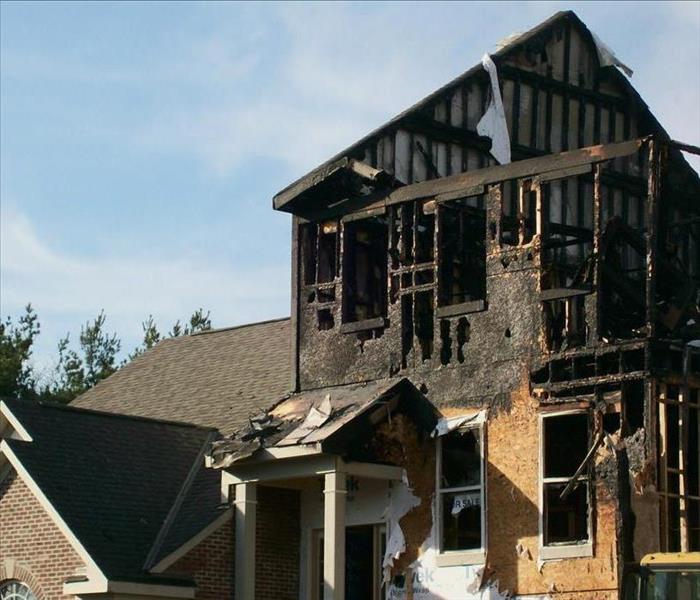 A two-story house that has been damaged by a fire.
A two-story house that has been damaged by a fire.
When dealing with fire damage cleanup, evaluate all areas for destruction, structural integrity, and safety hazards. Secure your property by reinforcing vulnerable points and clearing debris. Address smoke odor by assessing penetration levels and using specialized cleaning methods. Focus on thorough soot removal and proper ventilation to prevent health risks. Swiftly extract water, dehumidify, and apply antimicrobial treatments to prevent mold growth. Inspect diligently for mold and act promptly if found. Consider hiring professionals for efficient and effective cleanup. These tips lay a solid foundation for your fire damage restoration journey.
Key Takeaways
- Document damage thoroughly with photographs and detailed notes.
- Secure the property by identifying vulnerable areas and installing temporary fencing.
- Use specialized cleaning techniques and deodorization methods for smoke odor removal.
- Swift water extraction and dehumidification are essential for water-damaged areas.
- Hire professional cleanup services for efficient and effective fire damage restoration.
Assessing the Extent of Damage
To assess the extent of fire damage in your home, carefully inspect all affected areas for visible signs of destruction. Start by evaluating structural elements such as walls, ceilings, and floors for any signs of charring, warping, or weakening. Pay special attention to load-bearing walls and beams to ensure the safety and integrity of your home.
Next, prioritize safety by checking for any electrical hazards. Look for exposed wires, charred outlets, or any other signs of electrical damage. If you suspect any electrical issues, refrain from touching any electrical components and immediately shut off the power supply to the affected areas.
Additionally, assess the damage to any plumbing systems in your home. Check for leaks, burst pipes, or water damage resulting from firefighting efforts. It's essential to address any water-related issues promptly to prevent further damage and mold growth.
As you evaluate the extent of the fire damage, make a detailed list of all affected areas and items. Take photographs or videos to document the damage for insurance purposes. This documentation will also help you keep track of the restoration process and make sure that all necessary repairs are completed.
Securing the Property
Inspect the perimeter of your property to identify any vulnerable points that may require securing in the aftermath of a fire incident. Property protection is essential to prevent further damage or unauthorized access. Start by securing doors, windows, and any openings to deter potential intruders and safeguard your belongings. Guarantee that all entry points are properly locked and boarded up if necessary.
Implement safety measures to prevent accidents or injuries on the property. Clear any debris, fallen branches, or unstable structures that could pose a risk to individuals entering the premises. Place warning signs to alert people of potential hazards and restrict access to dangerous areas. Taking these precautions can help avoid additional harm and ensure the safety of anyone visiting the site.
Consider installing temporary fencing around the property to establish clear boundaries and enhance security. This can also prevent unwanted entry and protect the area from further damage. Additionally, consult with local authorities or fire department officials for guidance on securing the property effectively.
Contacting Insurance Company
When reaching out to your insurance company after a fire incident, promptly provide detailed information about the damages incurred for a smoother claims process. Start by contacting your insurance agent or the claims department as soon as possible. Be prepared to provide specific details about the fire damage, including the extent of the destruction, any personal belongings affected, and any injuries sustained. This information will help expedite the claims process and ensure that you receive the assistance you need.
Make sure you understand your coverage details before speaking with your insurance company. Familiarize yourself with your policy limitations, deductible amount, and any exclusions that may apply to fire damage. Knowing this information will help you have a more informed discussion with your insurer and set realistic expectations for the reimbursement options available to you.
During your conversation with the insurance company, take notes on important details such as the claim number, the name of the representative assisting you, and any instructions provided. Keep all communication documented for future reference. Remember to ask about the timeline for processing your claim and what steps you need to take to move the process forward efficiently.
Documenting the Damage
Start by carefully photographing and documenting the damage caused by the fire to provide thorough evidence for your insurance claim. When capturing images, make sure they're clear, focusing on all affected areas of your property. Take close-up shots to highlight specific damage, such as charred walls, smoke-stained ceilings, or soot-covered belongings. These visual records will be essential when filing your insurance claims, as they serve as tangible proof of the extent of the fire's impact.
In addition to photographs, make detailed written notes describing the damage. Include information about the date of the fire, the areas affected, and any valuable items that have been destroyed or damaged. This documentation will help support your insurance claim by providing a detailed overview of the losses incurred.
Organize all your evidence systematically, keeping it in a safe and easily accessible location. Consider creating both physical and digital copies to ensure redundancy and easy sharing with your insurance company. Remember that thorough and well-organized documentation can expedite the claims process and increase the likelihood of a successful outcome.
Implementing Smoke Odor Removal
To effectively eliminate smoke odors from your property, begin by evaluating the extent of the odor penetration in various surfaces and materials. Soot removal is essential in this process. Use specialized cleaning techniques to address soot residue on walls, ceilings, and other surfaces. For effective odor elimination, employ deodorization methods such as ozone treatment, thermal fogging, or using odor neutralizers. These methods can penetrate deep into materials to combat stubborn smoke odors.
After soot removal, focus on air purification. Implementing air purification systems like HEPA filters or activated charcoal filters can help in removing lingering smoke particles from the air. Additionally, improving ventilation in your property aids in dissipating odors. Consider opening windows and using fans to facilitate air circulation.
For localized smoke odor, spot-cleaning with vinegar solutions or baking soda can be effective. These household items can help neutralize odors in specific areas. Upholstery and carpets are common places where smoke odors linger; consider steam cleaning or professional cleaning services for these items.
Regularly clean HVAC systems and air ducts to prevent smoke odor particles from circulating. Maintain cleanliness in your property to prevent odors from settling into fabrics and surfaces. By diligently applying odor elimination techniques and air purification methods, you can effectively rid your property of persistent smoke odors.
Salvaging Personal Belongings
For salvaging personal belongings after a fire, prioritize items with sentimental value or indispensable importance. These possessions hold special memories that can't be bought or replicated.
Here are some tips to help salvage your belongings effectively:
- Use salvage techniques: Start by carefully sorting through the items in the affected area. Look for things like family photos, heirlooms, or handmade gifts that hold sentimental value. Use gloves to handle items to prevent further damage from oils on your skin. Place salvaged items in a safe, dry space to prevent additional harm.
- Consider restoration options: Delicate possessions like artwork, antiques, or vintage textiles may require professional restoration services. Research reputable restoration companies in your area that specialize in fire-damaged items. They have the expertise and tools needed to salvage and restore these delicate items to their former glory.
- Protect documents and valuables: Important documents such as passports, birth certificates, and financial records are indispensable to salvage. Use airtight containers or plastic sleeves to protect these items from further damage. Valuables like jewelry should be carefully inspected for soot or residue and cleaned by professionals if necessary.
Cleaning Soot and Residue
When addressing the aftermath of a fire, tackling the cleaning of soot and residue is vital to restoring your home and belongings. Soot removal techniques are essential in ensuring that your property is thoroughly cleaned. Begin by ventilating the area well to reduce inhalation risks. Use a high-efficiency particulate air (HEPA) vacuum to remove loose soot from surfaces carefully. Wipe down surfaces gently with a dry chemical sponge to lift off the remaining soot particles without smearing.
For residue cleaning methods, start by evaluating the type of residue left behind. Different residues require specific cleaning solutions for effective removal. For greasy residues, dish soap mixed with warm water can be a good starting point. Apply the solution with a sponge or cloth, ensuring that it does not spread the residue further. Rinse the area with clean water and dry it thoroughly. Enzymatic cleaners can be highly effective for protein-based residues.
Remember to wear appropriate protective gear, such as gloves and masks, when dealing with soot and residue. Avoid using water-based solutions on materials sensitive to moisture, like wood or paper. If in doubt, consult with professionals for guidance on the best cleaning approaches to prevent further damage to your belongings.
Restoring Water-damaged Areas
Restoration of water-damaged areas requires swift action to prevent further structural damage and mold growth. When facing water damage, following proper restoration techniques is essential. Here are three essential steps to help you effectively restore water-damaged areas:
- Water Extraction: The first step in restoring water-damaged areas is removing standing water promptly. Utilize pumps and specialized vacuums to extract water from the affected areas. Thorough water extraction is important to prevent additional damage to the structure and minimize the risk of mold growth.
- Dehumidification Process: After extracting the water, the next step is to dehumidify the space thoroughly. High humidity levels can prolong drying times and create an environment conducive to mold growth. Employ dehumidifiers and air movers to reduce moisture levels in the air and accelerate the drying process. Ensure proper ventilation to aid in the dehumidification process and prevent musty odors.
- Mold Prevention: Mold can start growing within 24 to 48 hours of water exposure, making mold prevention an important aspect of water damage restoration. Apply antimicrobial treatments to inhibit mold growth and thoroughly dry all affected areas. Inspect hidden spaces like wall cavities and under flooring to make sure no moisture is trapped, as these spots can become breeding grounds for mold.
Inspecting for Mold Growth
Inspecting for Mold Growth begins by thoroughly examining all water-damaged areas for any signs of mold presence, ensuring prompt detection and mitigation to prevent further damage. Mold can start growing within 24 to 48 hours after water exposure, making it vital to act swiftly. Look for visible mold, musty odors, and any discoloration on walls, ceilings, or floors. To prevent future mold growth, make sure all affected materials are completely dry. Use dehumidifiers, fans, and open windows to increase ventilation and aid in the drying process.
When dealing with mold removal, wear protective gear such as gloves, masks, and goggles to prevent exposure to mold spores. Scrub hard surfaces with a mixture of detergent and water, then thoroughly dry. Porous materials like carpets and insulation may need to be removed if heavily affected. HEPA vacuuming can help remove any remaining mold spores. After cleaning, apply mold inhibitors to prevent regrowth.
Inspecting for mold growth is essential to safeguard your health and property. By following proper mold removal techniques and taking preventive measures, you can ensure a clean and safe environment post-fire damage cleanup. Remember, quick action and thorough inspection are key to effectively managing mold growth in water-damaged areas.
Hiring Professional Cleanup Services
Consider outsourcing professional cleanup services to ensure thorough and efficient restoration of your property after fire damage. Hiring experts can save you time and ensure that the cleanup process is done effectively, helping you get back to your normal routine sooner.
Here are three reasons why professional cleanup services might be the best choice for you:
- Expertise and Experience: Professional cleanup services have the knowledge and experience to handle fire damage efficiently. They know how to assess the extent of the damage, which areas need priority attention, and the best methods to restore your property. Their expertise can help prevent further damage and ensure thorough cleanup.
- Specialized Equipment: Professional cleanup companies have access to specialized equipment and tools that are necessary for effective fire damage cleanup. From industrial-strength cleaners to advanced drying equipment, they've everything needed to remove soot, smoke odor, and water damage. This equipment is often expensive to rent or buy for a one-time cleanup job, making professional services a cost-effective choice.
- Cost Comparison: While DIY cleanup might seem like a more budget-friendly option at first, considering the overall cost is crucial. Professional cleanup services can provide a holistic solution that addresses all aspects of fire damage restoration, potentially saving you money in the long run by preventing future issues and ensuring thorough cleanup.
Wrap-Up
Following these top 10 fire damage cleanup tips will help you effectively and efficiently restore your property. By evaluating the damage, securing the property, contacting your insurance company, documenting the damage, implementing smoke odor removal, cleaning soot and residue, restoring water-damaged areas, inspecting for mold growth, and hiring professional cleanup services, you can ensure a thorough and successful cleanup process.
Don't hesitate to take action and get your property back to its pre-fire condition.
Fire Restoration Costs: What to Expect
3/26/2024 (Permalink)
When disaster strikes and your home is damaged by fire, the road to recovery can be overwhelming. The flames may have been extinguished, but the aftermath brings with it a series of challenges that must be addressed.
One of the biggest concerns is the cost of fire restoration. The expenses can quickly add up from initial assessment and cleanup to structural repairs and smoke removal.
But what exactly should you expect when it comes to fire restoration costs? How can you navigate the process and ensure you get a fair deal?
In this discussion, we will explore the various aspects of fire restoration costs and provide you with the information you need to make informed decisions.
Initial Assessment and Cleanup
When assessing and cleaning up after a fire, it's crucial to take immediate action to minimize further damage and ensure the safety of all individuals involved. The initial assessment is a critical step in this process, as it allows professionals to evaluate the extent of the damage and create a plan for effective cleanup.
During the initial assessment, trained experts will carefully examine the affected areas to determine the level of damage caused by the fire. They'll assess the structural integrity of the building and identify any potential hazards, such as weakened walls or electrical issues. This assessment plays a vital role in determining the scope of the cleanup and restoration efforts.
Once the initial assessment is complete, the cleanup can begin. This process involves removing debris, soot, and smoke residue from the affected areas. Professionals will use specialized equipment and cleaning agents to ensure thorough and safe removal. The goal is to eliminate any lingering traces of fire damage and restore the space to its pre-fire condition.
Cleanup after a fire also involves addressing water damage caused by firefighting efforts. Water extraction and drying techniques are employed to prevent mold growth and further structural damage. This step is crucial to prevent secondary issues that can arise from the presence of excess moisture.
Structural Repairs and Reconstruction
To restore the building after a fire, structural repairs and reconstruction are necessary. This process involves making the necessary repairs to damaged structural elements and rebuilding any parts of the building that were completely destroyed. Here are the key steps involved in structural repairs and reconstruction:
- Assessment and Planning: A thorough assessment is conducted to determine the extent of the damage and identify the areas that require structural reinforcement. This helps in creating a detailed plan for the repairs and reconstruction process.
- Obtaining Building Permits: Before starting any major structural repairs or reconstruction, building permits need to be obtained from the local authorities. These permits ensure that the work is done in compliance with the building codes and regulations.
- Structural Repairs and Reconstruction: Once the necessary permits are obtained, the structural repairs and reconstruction can begin. This involves repairing or replacing damaged beams, columns, walls, floors, and roofs. In cases where the damage is extensive, entire sections of the building may need to be reconstructed.
During this process, it's important to work with experienced contractors and engineers who specialize in fire restoration. They have the knowledge and expertise to ensure that the structural repairs and reconstruction are done correctly and safely.
It is worth noting that the cost of structural repairs and reconstruction can vary significantly depending on the extent of the damage and the size of the building. It's advisable to get multiple quotes from different contractors to ensure you're getting a fair price.
Smoke and Odor Removal
Smoke and odor removal is an essential step in the fire restoration process. After a fire, the lingering smell of smoke can be overwhelming and can make you feel like your space is no longer your own. But fear not because there are effective ways to eliminate these odors and restore a sense of belonging in your home.
One of the first steps in smoke and odor removal is air purification. This involves using specialized equipment to filter and clean the air, removing any lingering smoke particles and odorous molecules. Professional cleaning companies often have access to high-quality air purifiers that can effectively eliminate these unwanted smells. By investing in air purification, you can ensure that the air in your home is fresh and clean once again.
In addition to air purification, professional cleaning is another important aspect of smoke and odor removal. Trained professionals have the knowledge and expertise to thoroughly clean all affected surfaces, including walls, floors, and furniture. They use specialized cleaning products and techniques to remove smoke residue and eliminate any remaining odors. By hiring professionals for this task, you can have peace of mind knowing that your home is being cleaned to the highest standards.
Smoke and odor removal is crucial for creating a space that feels like your own again after a fire. By investing in air purification and professional cleaning, you can effectively eliminate smoke particles and odors, restoring a sense of belonging in your home. So don't let the aftermath of a fire make you feel disconnected from your space - take the necessary steps to remove smoke and odors and reclaim your home.
Content Restoration and Replacement
Content restoration and replacement is an essential part of the fire restoration process, ensuring that your belongings are restored or replaced after a fire.
When it comes to content restoration, there are several factors to consider, including the extent of the damage, the type of items involved, and the cost of restoration. Here's what you need to know:
- Assessment: The first step in content restoration is the assessment of your belongings. Trained professionals will evaluate the damage and determine what can be salvaged and restored. They'll take into account factors such as the type of material, the level of smoke or water damage, and the overall condition of the items.
- Restoration: Once the assessment is complete, the restoration process begins. This may involve specialized cleaning techniques, such as dry cleaning for clothing or ultrasonic cleaning for delicate items. Restoration professionals will use industry-approved methods and equipment to restore your belongings to their pre-fire condition.
- Replacement Costs: In some cases, restoration may not be possible, especially if the damage is severe. In such instances, replacement becomes necessary. Replacement costs can vary depending on the type and value of the items. It's important to work with your insurance company to determine the coverage for content replacement and ensure that you receive fair compensation for your losses.
Content restoration and replacement can be a time-consuming and costly process, but it's crucial to restore your sense of belonging and comfort after a fire. By entrusting the task to professionals and understanding the costs involved, you can navigate this aspect of fire restoration with confidence.
Insurance Coverage and Claims Process
If you have experienced a fire, understanding your insurance coverage and navigating the claims process is crucial for recovering your losses. Dealing with the aftermath of a fire can be overwhelming and stressful, but having the right insurance coverage can provide you with the financial support you need to rebuild and recover. However, it's important to keep in mind that there may be coverage limitations and requirements that you need to be aware of.
When it comes to insurance coverage for fire restoration, it's essential to review your policy carefully to understand what's covered and what's not. Most standard homeowners insurance policies cover fire damage, but there may be limitations on the extent of coverage. For example, your policy may have a cap on the amount of coverage for certain items or types of damages. It's crucial to be aware of these limitations so that you can set realistic expectations for the claims process.
Documenting the damages caused by the fire is a critical step in the insurance claims process. Take photos or videos of the affected areas and make a detailed list of all damaged items. This documentation will help support your claim and ensure you receive the appropriate compensation for your losses. Keeping receipts or proof of purchase for items destroyed in the fire is also a good idea.
When filing an insurance claim for fire restoration, it's important to notify your insurance company immediately. They'll guide you through the claims process and provide the necessary forms and information. Be prepared to provide documentation, such as the fire report, estimates from restoration professionals, and any other relevant information requested by your insurance company.
Review
So there you have it.
It's important to be prepared for the various stages of fire restoration costs. The expenses can add up quickly, from the initial assessment and cleanup to structural repairs and content restoration.
Common Fire Damage Restoration Mistakes to Avoid
3/8/2024 (Permalink)
Did you know that fire damage restoration can be a complex and challenging process? It's true, and there are several common mistakes that homeowners often make when dealing with the aftermath of a fire.
By avoiding these mistakes, you can ensure a smoother and more effective restoration process. So, what are these mistakes, and how can you avoid them?
Let's uncover the secrets to successful fire damage restoration and ensure that your home is restored to its pre-fire condition.
Delaying Professional Help
Don't make the mistake of delaying professional help when it comes to fire damage restoration. The importance of immediate action can't be stressed enough in such situations. When a fire occurs, it can cause significant damage to your property, leaving behind soot, smoke, and residue that can further deteriorate if not treated promptly. By delaying professional assistance, you risk facing potential long-term consequences that could have been avoided.
One of the main reasons why immediate action is crucial is because of the potential for further damage. After a fire, the affected areas can become vulnerable to structural issues, such as weakened walls or ceilings. Without proper restoration, these damages can worsen over time and compromise the safety of your home. Additionally, the longer you wait, the more difficult it becomes to remove the smoke odor and restore your property to its pre-fire condition.
Another important aspect to consider is the health risks associated with fire damage. Smoke and soot particles can penetrate into the air ducts and settle on surfaces, leading to respiratory issues, allergies, and other health problems. By delaying professional help, you expose yourself and your loved ones to these harmful pollutants for a longer period.
Furthermore, delaying fire damage restoration can also impact your insurance claim. Insurance companies require timely action and documentation to process your claim efficiently. If you delay seeking professional help, it may be challenging to provide the necessary evidence and documentation required for a successful claim.
Ignoring Hidden Damage
When you fail to address hidden damage, you risk exacerbating the long-term consequences that could have been avoided by seeking immediate professional help for fire damage restoration. It's crucial to thoroughly inspect your property after a fire to ensure that no hidden damage is left untreated. Ignoring hidden damage can lead to structural issues, compromised air quality, and increased costs for repairs in the long run.
Here's what you need to know about assessing structural integrity and evaluating air quality:
- Assessing structural integrity: Hidden fire damage can weaken the structural integrity of your property. It's essential to have a professional evaluate the extent of the damage and determine if any repairs or reinforcements are necessary. Ignoring this step can put you and your loved ones at risk of accidents or collapses.
- Evaluating air quality: Fires release toxic fumes and chemicals that can permeate your property, even in areas not directly affected by the flames. Failing to evaluate the air quality can result in respiratory issues and health problems. It's crucial to have professionals conduct air quality tests and implement appropriate ventilation and filtration systems if needed.
- Professional expertise: Ignoring hidden damage can lead to costly repairs down the line. By seeking immediate professional help, you can identify and address any hidden damage promptly and efficiently. Professionals have the knowledge, experience, and tools to accurately assess the extent of the damage and provide effective restoration solutions.
- Peace of mind: By addressing hidden damage, you can have peace of mind knowing that your property is safe and secure. Taking the necessary steps to restore your property after a fire ensures that you and your family can feel comfortable and protected in your home once again.
Don't underestimate the importance of addressing hidden damage after a fire. Seeking immediate professional help for fire damage restoration will help prevent further problems and ensure a safe and healthy environment for you and your loved ones.
Failing to Document the Damage
Make sure to document the damage caused by the fire to ensure accurate assessment and effective restoration. When your home or business is affected by a fire, it's crucial to thoroughly document the extent of the damage. Failing to do so can lead to difficulties when filing an insurance claim or seeking compensation for the restoration process.
To ensure that you receive the appropriate coverage and compensation, it's important to hire a public adjuster who specializes in fire damage. Hiring a public adjuster can be a game-changer when it comes to documenting fire damage. These professionals have the expertise and knowledge to accurately assess the extent of the damage and ensure that every detail is properly documented. They can assist you in navigating the complex process of filing an insurance claim, ensuring that you receive the maximum coverage for your fire damage restoration.
Insurance coverage for fire damage documentation is an essential aspect of the restoration process. Many insurance policies include coverage for documenting the damage caused by a fire. This coverage can help cover the costs associated with hiring a public adjuster and other professionals who'll assist in documenting the damage accurately. By taking advantage of this coverage, you can ensure that you have the necessary resources to properly assess the damage and restore your property.
Attempting DIY Cleanup
You should be cautious before attempting to clean up the fire damage on your own. While it may seem like a cost-effective and empowering solution, DIY cleanup can lead to potential health risks and ineffective restoration methods. Here are a few reasons why you should reconsider taking on the task yourself:
- Lack of expertise: Fire damage restoration requires specialized knowledge and skills. Without proper training, you may inadvertently cause further damage to your property or fail to address hidden issues such as smoke and soot residue.
- Safety hazards: Cleaning up after a fire involves handling hazardous materials, such as chemicals, asbestos, or mold. Without proper protective gear and knowledge of safety protocols, you risk exposing yourself to harmful substances and exacerbating the health risks associated with fire damage.
- Incomplete restoration: Fire damage goes beyond what's visible to the naked eye. Without professional equipment and techniques, you may fail to thoroughly clean and deodorize affected areas, leaving behind lingering odors and potential health hazards.
- Time and effort: Restoring a property after fire damage is a time-consuming and labor-intensive process. Taking on the task yourself can be overwhelming, especially if you have other responsibilities or lack the necessary tools and resources.
Neglecting to Address Smoke and Soot Residue
Before attempting DIY cleanup, it's important to address the smoke and soot residue left behind by the fire. Neglecting to address this residue can lead to serious health risks and hinder the restoration process.
Smoke and soot contain harmful chemicals and particles that can be detrimental to your health if inhaled or come into contact with your skin. Smoke residue can contain toxic substances such as carbon monoxide, formaldehyde, and volatile organic compounds (VOCs). These chemicals can cause respiratory problems, eye irritation, and skin allergies. Soot residue, on the other hand, contains fine particles that can easily become airborne and circulate throughout your home. Breathing in these particles can aggravate existing respiratory conditions and lead to long-term health issues.
In addition to the health risks, neglecting to address smoke and soot residue can also affect the effectiveness of the restoration process. These residues can penetrate walls, furniture, and other porous materials, leaving behind a strong odor and discoloration. Without proper cleaning and removal, this residue can continue to cause damage and impact the air quality in your home.
Proper ventilation plays a crucial role in fire damage restoration. It helps to remove smoke and soot particles from the air, allowing for a healthier and safer environment. By opening windows and using fans, you can increase air circulation and aid in the removal of harmful residues. It's important to consult with professionals who have the expertise and equipment to ensure proper ventilation during the restoration process.
Review
Don't underestimate the importance of professional fire damage restoration. Ignoring hidden damage, failing to document the extent of the destruction, attempting DIY cleanup, and neglecting smoke and soot residue can all lead to long-term consequences.
Don't risk it. Call the experts and ensure your home's full recovery.
The Hidden Dangers of Smoke Damage After a Fire
1/18/2024 (Permalink)
Imagine you've just survived a wildfire and finally returned to what's left of your home. The sight is devastating, with charred walls and a lingering smell of smoke. But you may not realize that the hidden dangers of smoke damage extend far beyond what meets the eye.
This article will explore the potential health risks, structural damage, long-term effects, and electrical hazards associated with smoke damage after a fire. Brace yourself because the aftermath of a fire is more complex and treacherous than you might think.
Health Risks Associated With Smoke Damage
Exposure to smoke damage from a fire can pose significant health risks to individuals. When a fire occurs, the burning materials release hazardous particles into the air. These particles can be inhaled, leading to a range of respiratory issues. Breathing in smoke can irritate the lungs and throat, making breathing difficult. It can also trigger or worsen respiratory conditions such as asthma or bronchitis.
The hazardous particles present in smoke can penetrate deep into the lungs, causing long-term damage. Prolonged exposure to smoke can lead to chronic respiratory diseases, including chronic obstructive pulmonary disease (COPD). This can result in a decreased quality of life and even premature death.
Furthermore, smoke damage can also affect the cardiovascular system. The toxic chemicals released during a fire can enter the bloodstream and increase the risk of heart attacks and strokes. Individuals with pre-existing heart conditions are particularly vulnerable in such situations.
It is important to note that the health risks associated with smoke damage can extend beyond immediate physical health. The emotional and psychological impact of experiencing a fire and its aftermath can be significant. The loss of personal belongings and the disruption of daily life can lead to stress, anxiety, and feelings of insecurity.
To protect yourself from the health risks of smoke damage, avoiding exposure as much as possible is crucial. If you find yourself in a fire-affected area, wearing a mask or using a respirator to filter out hazardous particles is recommended. It's also essential to seek medical attention if you experience any respiratory issues after being exposed to smoke.
Structural Damage Caused by Smoke
Smoke damage can cause significant structural damage to buildings and their contents. After a fire, it's important to assess the extent of the damage to determine the necessary structural repairs. Smoke can penetrate the structure, affecting the walls, ceilings, floors, and the foundation. This can weaken the overall integrity of the building and compromise its safety.
Structural repairs are crucial to restore the building to its pre-fire condition. Smoke damage can lead to corrosion and deterioration of structural materials like wood, metal, and concrete. The longer the smoke lingers, the more damage it can cause. It's important to address the structural damage promptly to prevent further deterioration and potential collapse.
Insurance coverage is an essential consideration when dealing with smoke damage. Most standard homeowner's insurance policies cover smoke damage, including the cost of structural repairs. However, reviewing your policy and understanding the specific coverage limits and exclusions is important. Some policies may restrict smoke damage caused by certain events, such as wildfires.
When filing an insurance claim for smoke damage, it's important to document the extent of the structural damage. Take photographs and make a detailed inventory of the affected areas and items. This documentation will help support your claim and ensure you receive adequate compensation for the necessary repairs.
Long-term Effects of Smoke Residue
To fully understand the impact of smoke damage on a building, it's crucial to consider the long-term effects of the residue left behind. While the immediate aftermath of a fire may seem devastating enough, the long-term health and property damage caused by smoke residue can be equally concerning.
One of the main long-term health concerns associated with smoke residue is the potential for respiratory issues. The particles and chemicals in the smoke can linger in the air and settle on surfaces, posing a risk to those in the building. Breathing in these particles over time can lead to respiratory problems such as asthma, bronchitis, and even lung cancer. It's important to thoroughly clean and remove all traces of smoke residue to protect the health of occupants.
In addition to the health risks, smoke residue can also cause significant property damage over time. The acidic nature of the residue can corrode and deteriorate various surfaces and materials in the building. This can damage walls, ceilings, furniture, and electrical systems, leading to costly repairs and replacements. Ignoring the presence of smoke residue can further deteriorate the building's structure, compromising its safety and value.
To minimize the long-term effects of smoke residue, seeking professional help for proper cleaning and restoration is essential. Experts can assess the extent of the damage and employ specialized techniques and products to remove the residue effectively. Regular maintenance and cleaning can also help prevent the accumulation of smoke residue and protect the long-term health and integrity of the building.
Electrical Hazards From Smoke Damage
After a fire, it's important to be aware of the potential electrical hazards from smoke damage. Smoke damage can have long-lasting effects on your home's electrical system, posing serious risks to your safety and your property's integrity.
Here are four key electrical hazards to watch out for during smoke damage cleanup and restoration:
- Damaged Wiring: Smoke residue can corrode electrical wiring, causing it to become brittle and prone to failure. This can lead to electrical shorts, sparks, and even electrical fires. It's crucial to have a professional electrician inspect and replace any damaged wiring to prevent further hazards.
- Overloaded Circuits: Smoke damage may compromise the capacity of your electrical circuits. When circuits are overloaded, they can overheat and potentially cause electrical fires. Assess the electrical load in your home and redistribute it as needed to avoid putting too much strain on any one circuit.
- Malfunctioning Appliances: Smoke residue can infiltrate appliances and cause them to malfunction. Faulty appliances pose a safety risk and can further damage your home's electrical system. Thoroughly clean and inspect all appliances affected by smoke damage before using them again.
- Hidden Damage: Smoke damage can be deceptive, lurking behind walls and in hard-to-reach areas. Conducting a comprehensive assessment of your home's electrical system is crucial to identify any hidden damage caused by smoke. This will ensure that all necessary repairs are made and that your electrical system is restored to a safe and functional state.
Importance of Professional Smoke Damage Restoration
To ensure the safety and integrity of your home's electrical system after smoke damage from a fire, you must prioritize professional smoke damage restoration services. While it may be tempting to try and handle the cleanup and restoration on your own, it's important to understand the potential risks and the benefits of hiring professionals.
One of the main reasons professional smoke damage restoration is crucial is that it can help prevent costly restoration processes down the line. Smoke damage can be deceptive, as it can seep into areas that aren't immediately visible, such as behind walls or air ducts. If not properly addressed, this hidden damage can lead to more severe problems in the future, including structural damage and mold growth. Hiring professionals can thoroughly assess the extent of the smoke damage and ensure that all affected areas are properly cleaned and restored, ultimately saving you from expensive repairs in the long run.
Another important aspect to consider is insurance coverage. Most insurance policies cover smoke damage and its restoration, but they often require professional services to be used. Hiring professionals guarantees that the restoration is done correctly and ensures that you can make a successful claim with your insurance company. They'll provide detailed documentation of the restoration process, which is crucial for insurance purposes.
Wrap-Up
The hidden dangers of smoke damage after a fire aren't to be underestimated. The consequences can be severe, from health risks and structural damage to long-term effects and electrical hazards.
Remember, 'an ounce of prevention is worth a pound of cure.' So, seeking professional smoke damage restoration is crucial to ensure your safety and protect your property.
Don't wait until it's too late – take action now and prioritize your well-being.
Fire Damage Restoration: Everything You Need to Know
11/30/2023 (Permalink)
The charred aftermath of a fire can be devastating, leaving property owners with an overwhelming sense of loss and despair. Understanding the nuances of fire damage restoration is paramount in such trying times. SERVPRO of South and Northwest Grand Rapids aims to provide you with a comprehensive guide on the subject, shedding light on the intricacies of the restoration process and helping you navigate the tumultuous aftermath of a fire.
Understanding the Types of Fire Damage
Structural Damage
Fire can wreak havoc on a building's structural integrity, weakening supports, beams, and foundations. Understanding the extent of this damage is crucial, as it dictates the complexity and scope of the restoration process.
Soot and Smoke Residue
The insidious aftermath of a fire often lingers in the form of soot and smoke residue. This fine particulate matter can infiltrate every nook and cranny, posing health risks and requiring meticulous removal.
Water Damage from Firefighting Efforts
While water may be an ally in extinguishing flames, it can become an enemy when it seeps into the structure. Understanding how to deal with this secondary damage is integral to a successful restoration.
The Restoration Process
Assessment and Damage Categorization
Upon arrival, a professional restoration team assesses the extent and nature of the damage. This categorization is vital in formulating a precise plan of action.
Safety Measures and Hazard Mitigation
Ensuring the safety of all involved is a top priority. Hazards, such as weakened structures and electrical issues, must be addressed before commencing restoration.
Securing the Property
A fire-damaged property is vulnerable to further damage and looting. Discover how experts secure the site to prevent additional losses.
Smoke and Soot Removal
The meticulous process of removing smoke and soot is a vital step. Learn about advanced techniques and equipment used to eliminate these contaminants.
Dealing with Water Damage
Effective water damage restoration involves thorough extraction, drying, and dehumidification to prevent long-term issues like mold growth.
Structural Repairs and Reconstruction
Discover the intricacies of rebuilding a fire-damaged structure, from repairing weakened foundations to restoring the property's aesthetic appeal.
Odor Elimination
Smoke odors can persist long after the flames are gone. Explore innovative methods used by restoration experts to eliminate these stubborn odors.
Costs and Budgeting
Initial Assessment Costs
Discover the costs associated with the initial assessment, which is the foundation for your restoration budget.
Restoration Budgeting
Effectively budgeting for restoration is essential. Explore the factors that influence your budget and how to prepare for unexpected expenses.
Hidden Costs to Consider
Beyond the visible expenses, there are hidden costs to be mindful of. We unveil these potential financial burdens and how to account for them.
Timelines and Project Management
Setting Realistic Timelines
Restoration is a time-sensitive endeavor. Learn how to set realistic timelines and what factors can impact the project's duration.
Project Monitoring and Communication
Effective communication with your restoration team is crucial for keeping the project on track. Discover best practices for maintaining a transparent and productive dialogue.
Potential Delays and Setbacks
Unforeseen delays and setbacks can occur during restoration. Understanding these possibilities and how to mitigate them is essential for a smoother process.
Preventing Future Fire Damage
Fire-Resistant Materials and Design
Proactive measures to prevent future fires include using fire-resistant materials and implementing fire-safe architectural designs.
Safety and Evacuation Plans
Developing comprehensive safety and evacuation plans can be the difference between life and death during a fire emergency.
Maintenance and Inspections
Regular maintenance and inspections are essential for identifying and addressing potential fire hazards before they escalate.
Summary
In the aftermath of a fire, fire damage restoration is the beacon of hope. It is the path to recovery and restoration. By understanding the process, hiring the right professionals, and being prepared, you can confidently navigate this challenging journey and, ultimately, rebuild what was lost.
For any questions or to schedule an appointment, please reach out to SERVPRO of South and Northwest Grand Rapids.
How to Handle Workplace Fire Hazards
9/13/2023 (Permalink)
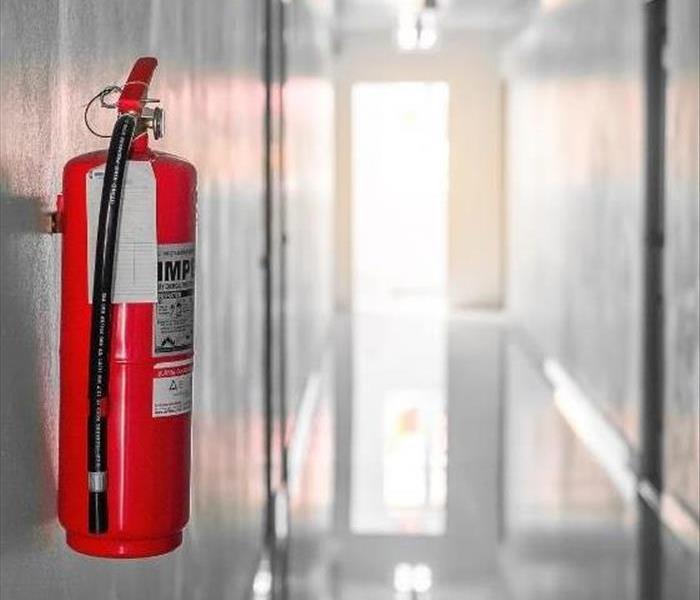 Fire hazards in the workplace are a significant concern for business owners and managers.
Fire hazards in the workplace are a significant concern for business owners and managers.
Key Takeaways:
- Identify and address potential fire hazards in the workplace
- Train employees on fire safety and evacuation procedures
- Regularly inspect and maintain fire safety equipment
- Develop a fire emergency plan and review it periodically
Workplace fire hazards are a significant concern for business owners and managers. Not only can a fire result in devastating property loss, but it can also put employees and customers at risk of injury or death. It is essential to take proactive measures to identify and address potential fire hazards before they become a serious problem.
In this article, we’ll discuss some of the most common workplace fire hazards and provide tips on how to prevent them from causing harm. We’ll also explain what to do in case of a fire and how to get your business back on track after a fire has occurred.
Common Workplace Fire Hazards
There are several workplace fire hazards that property managers should know, including:
Electrical Hazards
Electrical hazards are one of the most common causes of workplace fires. Faulty wiring, overloaded outlets, and damaged equipment can all pose a significant risk. To prevent electrical fires, it’s essential to have regular electrical inspections and ensure that all equipment is properly maintained.
Combustible Materials
Combustible materials such as paper, cardboard, and chemicals can easily catch fire and spread flames. To prevent fires caused by combustible materials, ensure that these items are stored away from heat sources, and properly disposed of when no longer needed.
Cooking Equipment
Kitchens and break rooms that contain cooking equipment pose a significant fire hazard. It’s important to ensure that cooking equipment is well-maintained, and that employees are trained in proper kitchen safety procedures.
Smoking
Smoking is a common cause of workplace fires, particularly in outdoor areas where smoking is allowed. To prevent fires caused by smoking, establish designated smoking areas away from buildings and provide ashtrays for employees to dispose of cigarette butts safely.
Preventing Workplace Fires
Preventing workplace fires is crucial to protecting your business and employees. Here are some tips to help you prevent fires in the workplace:
Conduct Regular Inspections
Regular inspections can help identify potential fire hazards before they become a serious problem. Electrical systems, heating and cooling systems, and cooking equipment should all be inspected regularly to ensure that they are in good working condition.
Establish Fire Safety Procedures
Establish fire safety procedures and ensure that all employees are trained in them. This includes knowing how to use fire extinguishers, where to go in case of a fire, and how to evacuate the building safely.
Store Flammable Materials Safely
Store flammable materials such as gasoline, chemicals, and cleaning products in a secure location away from heat sources. Properly label all containers and ensure that they are tightly sealed.
Install Smoke Detectors
Smoke detectors are an essential safety feature in any workplace. Install smoke detectors throughout the building and check them regularly to ensure they are working correctly.
Responding to a Workplace Fire
Despite best efforts to prevent workplace fires, sometimes they can still occur. If a fire breaks out in your workplace, it’s important to remain calm and follow these steps:
- Evacuate the Building: Immediately evacuate the building and ensure that all employees are accounted for.
- Call for Help: Call 911 and inform the emergency operator of the location of the fire.
- Do Not Attempt to Put Out the Fire: Unless you are trained to do so, do not attempt to put out the fire. Leave it to the professionals.
- Contact SERVPRO of South and Northwest Grand Rapids: Contact a professional fire damage restoration company like SERVPRO of South and Northwest Grand Rapids to assess the damage and begin the restoration process.
Final Thoughts
Workplace fires are a serious threat that every business owner and manager must take seriously. You can protect your workplace from disaster by identifying potential fire hazards, establishing fire safety procedures, and responding quickly in the event of a fire.
How SERVPRO Cleans Up a House Fire
9/1/2023 (Permalink)
Key Takeaways:
- Smoke and fire damage require different cleaning methods.
- SERVPRO conducts a thorough assessment to create an action plan.
- SERVPRO utilizes specialized equipment and techniques for cleaning.
- SERVPRO can restore your home to its pre-fire condition.
Experiencing a house fire is a traumatic event that can leave lasting damage and stress on both residential homeowners and commercial property managers. Smoke and fire damage can be overwhelming to deal with, but with the help of a professional restoration company, you can get your property back to its pre-fire condition. SERVPRO of South and Northwest Grand Rapids is a national leader in fire and smoke restoration services, providing comprehensive and effective solutions for homeowners and commercial property managers.
Understanding the Difference Between Fire and Smoke Damage
Before discussing how SERVPRO cleans up a house fire, it is important to understand the difference between fire and smoke damage. Fire damage refers to the physical damage that occurs because of the flames, such as burned walls, floors, and ceilings. Smoke damage refers to the damage caused by the smoke that can spread throughout the property, leaving behind soot and odor.
Both fire and smoke damage require immediate attention to prevent further damage from occurring. SERVPRO of South and Northwest Grand Rapids offers 24-hour emergency service to respond quickly to the scene and assess the damage.
The SERVPRO Cleaning Process
After responding to the scene, SERVPRO of South and Northwest Grand Rapids develops a detailed action plan for restorative cleaning. This plan outlines the steps required to restore the property to its pre-fire condition.
Step 1: Assessment
The first step in the cleaning process is to assess the damage. SERVPRO technicians thoroughly inspect the property to determine the extent of the damage caused by the fire and smoke. This assessment allows them to develop an effective action plan that is tailored to the specific needs of the property.
Step 2: Mitigation
Once the assessment is complete, the next step is mitigation. SERVPRO technicians take steps to prevent further damage from occurring. This includes boarding up windows and doors, tarping the roof, and removing excess water caused by firefighting efforts.
Step 3: Restoration
The restoration process is where SERVPRO technicians begin to clean and restore the property. This includes removing debris, soot, and smoke damage from all affected areas. SERVPRO utilizes specialized equipment and techniques to remove soot and odor from furniture, walls, floors, and ceilings. They also use air scrubbers and dehumidifiers to remove any remaining smoke odor from the property.
Step 4: Reconstruction
The final step in the SERVPRO cleaning process is reconstruction. This step involves repairing any structural damage caused by the fire. SERVPRO works with licensed contractors to ensure that all repairs are done correctly and up to code.
Why Choose SERVPRO of South and Northwest Grand Rapids?
SERVPRO of South and Northwest Grand Rapids is a nationally recognized leader in fire and smoke restoration services. Their team of trained professionals has the knowledge and experience to provide comprehensive solutions for both residential and commercial properties. They use the latest equipment and techniques to ensure that each room is restored to its pre-fire condition, leaving no trace of smoke or fire damage.
Choosing SERVPRO of South and Northwest Grand Rapids for your fire restoration needs ensures that your property is in the hands of experts who understand the urgency and stress of the situation. They work efficiently and effectively to restore your property, providing you with peace of mind during a difficult time.
Final Thoughts
Experiencing a house fire is a traumatic event that can leave lasting damage and stress on both residential homeowners and commercial property managers. However, with the help of a professional restoration company like SERVPRO of South and Northwest Grand Rapids, you can get your property back to its pre-fire condition quickly and efficiently.
The Benefits of Professional Fire Damage Restoration
8/10/2023 (Permalink)
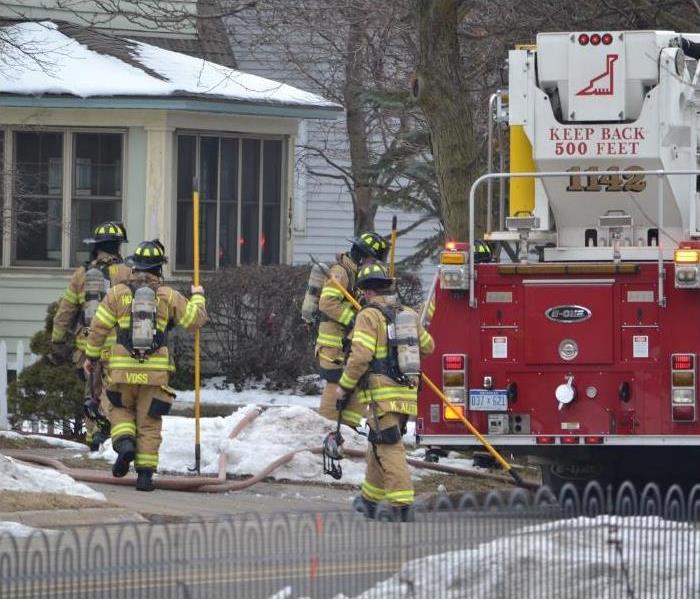 Experiencing a house fire can be a traumatic and devastating event that can cause significant damage to your property and belongings.
Experiencing a house fire can be a traumatic and devastating event that can cause significant damage to your property and belongings.
Key Takeaways:
- Professional fire damage restoration is essential to ensure safety.
- Restoration companies have the expertise, tools, and experience to restore homes.
- Quick restoration can save time, money, and prevent further damage.
- Professional restoration can help homeowners cope with the aftermath.
Experiencing a house fire can be a traumatic and devastating event that can cause significant damage to your property and belongings. The aftermath of a fire can be overwhelming, leaving you with many questions and concerns. Fortunately, professional fire damage restoration services like SERVPRO of South and Northwest Grand Rapids are available to help you navigate the restoration process and provide you with the answers and peace of mind you need to put your life back together.
This article will explore the benefits of professional fire damage restoration services and how they can help you get back on your feet after a fire.
Comprehensive Restoration Services
One of the main benefits of hiring a professional fire damage restoration company is that they offer comprehensive restoration services that cover all aspects of the restoration process. This includes everything from initial assessment and cleanup to repairs and reconstruction. Utilizing a single company for all your restoration needs can streamline the process and ensure that your property is restored quickly and efficiently.
Knowledge and Expertise
Professional fire damage restoration companies like SERVPRO of South and Northwest Grand Rapids have abundant knowledge and expertise in handling fire damage. They understand the complexities of the restoration process and have the experience and training necessary to handle even the most severe cases. This means you can trust them to assess the damage properly, develop a restoration plan, and execute it with precision and efficiency.
Quick Response Time
Time is of the essence when it comes to fire damage restoration. The longer you wait to address the damage, the more extensive and costly the repairs will be. Professional restoration companies understand this and are equipped to respond quickly to your needs. They have the tools and resources necessary to start the restoration process immediately, helping to minimize the damage and get your property back to pre-fire condition as quickly as possible.
Insurance Claims Assistance
Dealing with insurance companies can be a daunting task, especially after experiencing a fire. Professional fire damage restoration companies like SERVPRO of South and Northwest Grand Rapids can assist you with the insurance claims process by providing detailed documentation of the damage and the restoration process. This can help expedite the claims process and ensure that you receive the maximum coverage available under your policy.
Final Thoughts
Experiencing a house fire can be a traumatic and overwhelming experience, but it doesn’t have to be. Professional fire damage restoration services can provide you with the expertise, resources, and peace of mind to put your life back together. Utilizing a single company for all your restoration needs can streamline the process and ensure that your property is restored quickly and efficiently. So, if you’re dealing with the aftermath of a fire, contact the professionals at SERVPRO of South and Northwest Grand Rapids to help you get back on your feet.
Can Fireplaces Damage Other Areas of My House?
8/1/2023 (Permalink)
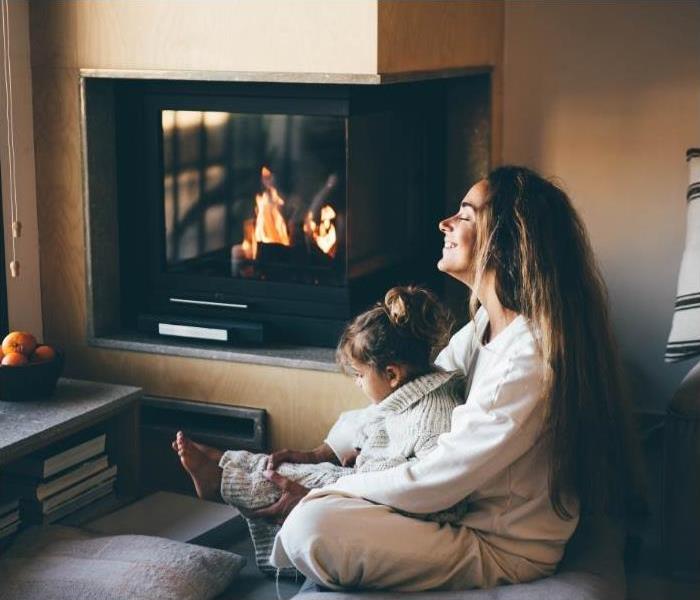 Fireplaces are a popular addition to many homes, providing warmth and comfort during the cold winter months.
Fireplaces are a popular addition to many homes, providing warmth and comfort during the cold winter months.
Key Takeaways:
- Fireplaces can damage homes without proper maintenance and operation
- Risks include creosote buildup, incorrect installation, and human error
- Prevent fires with regular maintenance and safe operation practices
- In case of a fire, evacuate and seek professional assistance.
Fireplaces are a popular addition to many homes, providing warmth and comfort during the cold winter months. However, these cozy features can pose a risk to your property if not properly maintained. The question remains, can fireplaces damage other areas of your house? The short answer is yes. In this article, we’ll explore the dangers of fireplace house fires and what you can do to prevent them.
What Are the Risks of Fireplace House Fires?
When a fireplace is not properly maintained or operated, it can start a fire that can quickly spread throughout your home, causing extensive damage. This can be due to a variety of factors, including:
Lack of Maintenance
Fireplaces require regular maintenance to ensure they are safe and efficient. When left unmaintained, creosote (a highly flammable substance that builds up in the chimney) can accumulate and ignite, causing a chimney fire that can quickly spread to other areas of the house.
Incorrect Installation
A poorly installed or malfunctioning fireplace can also pose a risk. For example, if the chimney is too close to combustible materials or if there is a blockage in the chimney, a house fire can occur.
Human Error
Improper use of the fireplace can also lead to a fire. For example, using improper fuel sources, failing to use a screen or glass doors, and leaving the fire unattended can all lead to a dangerous situation.
Preventing Fireplace House Fires
Preventing fireplace house fires requires a combination of regular maintenance and safe operation. Here are some tips to help prevent a house fire caused by your fireplace:
Regular Maintenance
- Have your chimney inspected and cleaned by a professional chimney sweep at least once a year.
- Make sure your chimney is properly lined and in good condition.
- Install a chimney cap to prevent debris from entering the chimney and causing a blockage.
- Only burn dry, seasoned wood to reduce the buildup of creosote.
Safe Operation
- Always use a screen or glass doors to prevent sparks from escaping the fireplace.
- Never leave a fire unattended and make sure the fire is completely extinguished before leaving the room or going to bed.
- Use only approved fuel sources, such as dry wood or manufactured logs.
- Keep combustible materials at least three feet away from the fireplace.
What to Do in Case of a Fireplace House Fire
If a house fire does occur, it’s important to act quickly. Follow these steps:
- Get everyone out of the house and call 911 immediately.
- Do not attempt to put out the fire yourself.
- Contact SERVPRO of South and Northwest Grand Rapids for professional fire restoration services.
Final Thoughts
Fireplaces can and will pose a significant risk to your home if not properly maintained and operated. However, with regular maintenance and safe operation, you can enjoy the warmth and comfort of your fireplace without the risk of a house fire. And in the event of a fire, remember to act quickly and contact the professionals at SERVPRO of South and Northwest Grand Rapids for expert fire restoration services.
Garage Fire Restoration in Grand Rapids
6/26/2023 (Permalink)
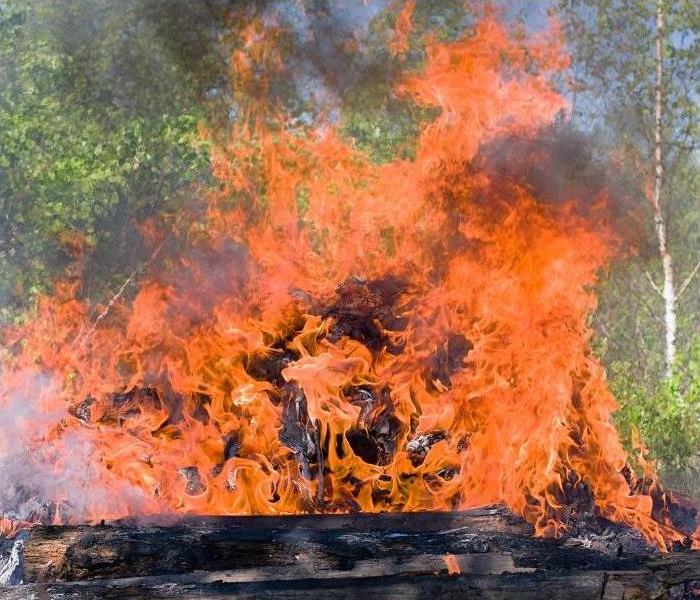 SERVPRO can help with garage fire restoration in Grand Rapids.
SERVPRO can help with garage fire restoration in Grand Rapids.
Key Takeaways
- Garage fires can cause extensive physical and emotional damage.
- Enlisting experts in fire damage restoration is crucial for recovery.
- The restoration process involves emergency contact, assessment, cleaning, and reconstruction.
- SERVPRO of South and Northwest Grand Rapids can help restore your garage after a fire.
If your property experiences a garage fire, it can cause physical damages to belongings, but also presents distressing consequences from the heavy financial toll upwards of thousands of dollars. Fortunately, there are strategies you can use to aid in recovery, beginning with enlisting experts who specialize in restoring properties after all types of fires. SERVPRO of South and Northwest Grand Rapids has the expertise and tools necessary to restore your garage after a fire, and get your property back to pre-fire condition.
The Effects of a Garage Fire
Garage fires can be particularly devastating because they often contain flammable materials, such as gasoline, propane, and other chemicals. When these materials ignite, they can quickly spread and cause extensive damage to the structure and contents of the garage. The high heat and flames from a garage fire can also cause damage to nearby structures, including your home.
In addition to physical damages, a garage fire can also cause emotional distress for homeowners. Losing belongings and sentimental items can be difficult to come to terms with. Fortunately, the process of garage fire damage restoration can help alleviate some of these emotional stressors.
Steps for Garage Fire Damage Restoration
The restoration process for a garage fire typically involves several steps:
1. Emergency Contact
The first step in garage fire damage restoration is to contact SERVPRO of South and Northwest Grand Rapids. We offer 24/7 emergency services and can quickly respond to your call. Our team will arrive on the scene and assess the damage, as well as provide an estimate for the restoration process.
2. Inspection and Assessment
Next, our team will thoroughly inspect the garage to assess the extent of the damage. This includes assessing both the structural and contents damage, as well as checking for any safety hazards. We will then create a plan for the restoration process, which may include cleaning, repairs, and replacement of damaged items.
3. Cleaning and Restoration
The cleaning and restoration process will involve removing any debris and damaged materials, as well as cleaning and disinfecting the garage. We may use specialized equipment to remove smoke and soot, as well as restore the structure and contents of the garage to pre-fire condition.
4. Reconstruction
Our team will also provide reconstruction services to restore the structure of the garage. This may include repairing walls, roofs, and flooring, as well as any necessary electrical or plumbing work.
5. Final Walk-Through
Finally, we will conduct a final walk-through with you to ensure that you are satisfied with the restoration process. We will also provide tips and recommendations for preventing future fires and maintaining the integrity of your garage.
Final Thoughts
Garage fires can be devastating, but with the help of SERVPRO of South and Northwest Grand Rapids, you can recover from the damages and get your property back to pre-fire condition. Our team of experts has the experience and tools necessary to handle all aspects of garage fire damage restoration, from inspection and assessment to cleaning and reconstruction. Contact us today to learn more about our services and how we can help you restore your property after a garage fire.
Garage Fire Restoration in Grand Rapids
5/24/2023 (Permalink)
 One spark landing on the wrong thing could cause a garage fire.
One spark landing on the wrong thing could cause a garage fire.
Key Takeaways
- Garage fires can cause extensive physical and emotional damage.
- Enlisting experts in fire damage restoration is crucial for recovery.
- The restoration process involves emergency contact, assessment, cleaning, and reconstruction.
- SERVPRO of South and Northwest Grand Rapids can help restore your garage after a fire.
If your property experiences a garage fire, it can cause physical damages to belongings, but also presents distressing consequences from the heavy financial toll upwards of thousands of dollars. Fortunately, there are strategies you can use to aid in recovery, beginning with enlisting experts who specialize in restoring properties after all types of fires. SERVPRO of South and Northwest Grand Rapids has the expertise and tools necessary to restore your garage after a fire, and get your property back to pre-fire condition.
The Effects of a Garage Fire
Garage fires can be particularly devastating because they often contain flammable materials, such as gasoline, propane, and other chemicals. When these materials ignite, they can quickly spread and cause extensive damage to the structure and contents of the garage. The high heat and flames from a garage fire can also cause damage to nearby structures, including your home.
In addition to physical damages, a garage fire can also cause emotional distress for homeowners. Losing belongings and sentimental items can be difficult to come to terms with. Fortunately, the process of garage fire damage restoration can help alleviate some of these emotional stressors.
Steps for Garage Fire Damage Restoration
The restoration process for a garage fire typically involves several steps:
1. Emergency Contact
The first step in garage fire damage restoration is to contact SERVPRO of South and Northwest Grand Rapids. We offer 24/7 emergency services and can quickly respond to your call. Our team will arrive on the scene and assess the damage, as well as provide an estimate for the restoration process.
2. Inspection and Assessment
Next, our team will thoroughly inspect the garage to assess the extent of the damage. This includes assessing both the structural and contents damage, as well as checking for any safety hazards. We will then create a plan for the restoration process, which may include cleaning, repairs, and replacement of damaged items.
3. Cleaning and Restoration
The cleaning and restoration process will involve removing any debris and damaged materials, as well as cleaning and disinfecting the garage. We may use specialized equipment to remove smoke and soot, as well as restore the structure and contents of the garage to pre-fire condition.
4. Reconstruction
Our team will also provide reconstruction services to restore the structure of the garage. This may include repairing walls, roofs, and flooring, as well as any necessary electrical or plumbing work.
5. Final Walk-Through
Finally, we will conduct a final walk-through with you to ensure that you are satisfied with the restoration process. We will also provide tips and recommendations for preventing future fires and maintaining the integrity of your garage.
Why Call SERVPRO?
Garage fires can be devastating, but with the help of SERVPRO of South and Northwest Grand Rapids, you can recover from the damages and get your property back to pre-fire condition. Our team of experts has the experience and tools necessary to handle all aspects of garage fire damage restoration, from inspection and assessment to cleaning and reconstruction. Contact us today to learn more about our services and how we can help you restore your property after a garage fire.
Garage Fire Restoration in Grand Rapids
5/7/2023 (Permalink)
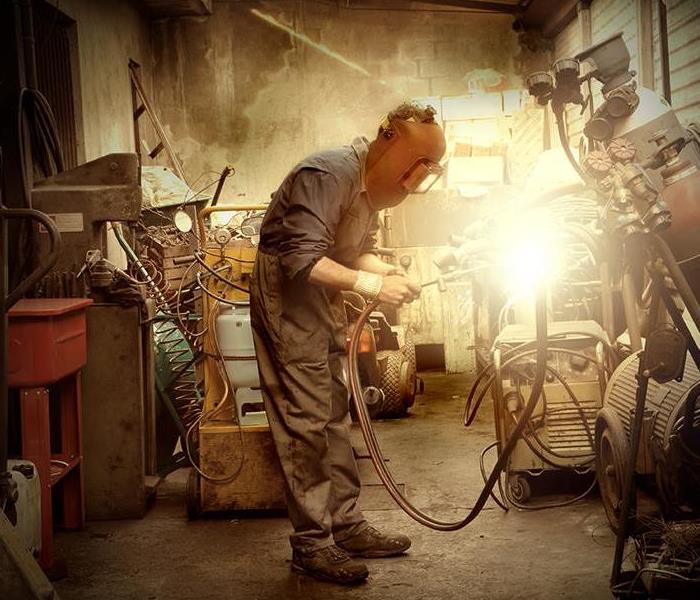 One never knows what may catch their garage on fire, but when it does, SERVPRO of South and Northwest Grand Rapids can help.
One never knows what may catch their garage on fire, but when it does, SERVPRO of South and Northwest Grand Rapids can help.
Key Takeaways
- Garage fires can cause extensive physical and emotional damage.
- Enlisting experts in fire damage restoration is crucial for recovery.
- The restoration process involves emergency contact, assessment, cleaning, and reconstruction.
- SERVPRO of South and Northwest Grand Rapids can help restore your garage after a fire.
If your property experiences a garage fire, it can cause physical damages to belongings, but also presents distressing consequences from the heavy financial toll upwards of thousands of dollars. Fortunately, there are strategies you can use to aid in recovery, beginning with enlisting experts who specialize in restoring properties after all types of fires. SERVPRO of South and Northwest Grand Rapids has the expertise and tools necessary to restore your garage after a fire, and get your property back to pre-fire condition.
The Effects of a Garage Fire
Garage fires can be particularly devastating because they often contain flammable materials, such as gasoline, propane, and other chemicals. When these materials ignite, they can quickly spread and cause extensive damage to the structure and contents of the garage. The high heat and flames from a garage fire can also cause damage to nearby structures, including your home.
In addition to physical damages, a garage fire can also cause emotional distress for homeowners. Losing belongings and sentimental items can be difficult to come to terms with. Fortunately, the process of garage fire damage restoration can help alleviate some of these emotional stressors.
Steps for Garage Fire Damage Restoration
The restoration process for a garage fire typically involves several steps:
1. Emergency Contact
The first step in garage fire damage restoration is to contact SERVPRO of South and Northwest Grand Rapids. We offer 24/7 emergency services and can quickly respond to your call. Our team will arrive on the scene and assess the damage, as well as provide an estimate for the restoration process.
2. Inspection and Assessment
Next, our team will thoroughly inspect the garage to assess the extent of the damage. This includes assessing both the structural and contents damage, as well as checking for any safety hazards. We will then create a plan for the restoration process, which may include cleaning, repairs, and replacement of damaged items.
3. Cleaning and Restoration
The cleaning and restoration process will involve removing any debris and damaged materials, as well as cleaning and disinfecting the garage. We may use specialized equipment to remove smoke and soot, as well as restore the structure and contents of the garage to pre-fire condition.
4. Reconstruction
Our team will also provide reconstruction services to restore the structure of the garage. This may include repairing walls, roofs, and flooring, as well as any necessary electrical or plumbing work.
5. Final Walk-Through
Finally, we will conduct a final walk-through with you to ensure that you are satisfied with the restoration process. We will also provide tips and recommendations for preventing future fires and maintaining the integrity of your garage.
Final Thoughts
Garage fires can be devastating, but with the help of SERVPRO of South and Northwest Grand Rapids, you can recover from the damages and get your property back to pre-fire condition. Our team of experts has the experience and tools necessary to handle all aspects of garage fire damage restoration, from inspection and assessment to cleaning and reconstruction. Contact us today to learn more about our services and how we can help you restore your property after a garage fire.
4 Most Common Causes of a Kitchen Fire
4/21/2023 (Permalink)
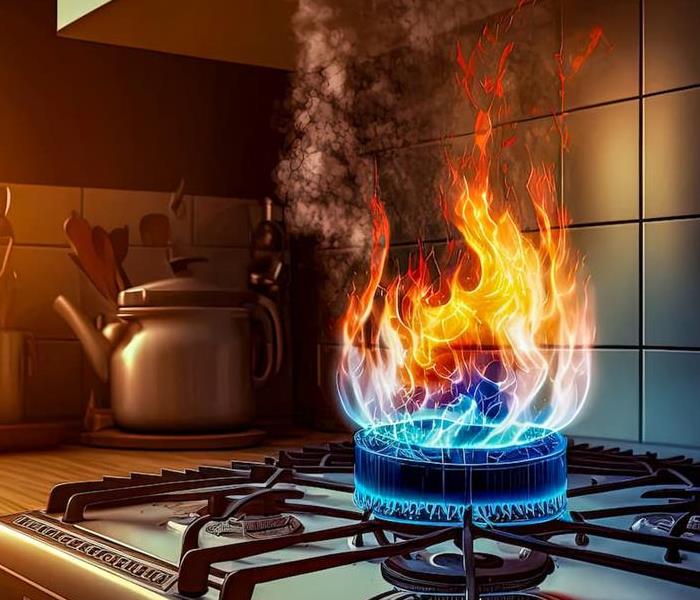 Leaving cooking equipment out too long on an open flame is one of the leading causes of kitchen fires.
Leaving cooking equipment out too long on an open flame is one of the leading causes of kitchen fires.
Key Takeaways
- Cooking equipment is the leading cause of kitchen fires.
- Electrical equipment and heating equipment can also cause fires.
- Carelessness with flames, such as candles and cigarettes, is dangerous.
- Prevention measures, such as staying alert and regular cleaning, are crucial.
What Makes a Kitchen Fire So Dangerous?
Kitchen fires are one of the most dangerous types of home fires and can be particularly devastating for property managers and homeowners. Unaddressed safety hazards in kitchens can put these spaces at an increased risk for fire, making it essential to understand what contributes to them and how they can be prevented.
At SERVPRO of South and Northwest Grand Rapids, we’ve seen the devastating effects of kitchen fires firsthand. In this article, we’ll discuss the four most common causes of kitchen fires, as well as provide tips on how to prevent them.
Cause #1: Cooking Equipment
Cooking equipment is the leading cause of kitchen fires. Pots and pans left unattended on the stove can easily overheat, causing a fire to ignite. Grease buildup on the stove or in the oven can also contribute to fires.
To prevent cooking equipment from causing a fire, always stay in the kitchen while cooking, and never leave the stove unattended. Keep flammable objects, such as towels and oven mitts, away from the stove. Clean the stove and oven regularly to remove any grease buildup.
Cause #2: Electrical Equipment
Electrical equipment, such as toasters, coffee makers, and microwaves, can also cause kitchen fires. Overloading outlets, using frayed cords, and leaving appliances plugged in when not in use can all contribute to electrical fires.
To prevent electrical equipment from causing a fire, make sure to never overload outlets or use frayed cords. Unplug appliances when not in use and keep them away from flammable materials.
Cause #3: Heating Equipment
Heating equipment, such as space heaters and portable heaters, can also cause kitchen fires. Placing these heaters too close to flammable materials or leaving them unattended can cause a fire to ignite.
To prevent heating equipment from causing a fire, always keep them away from flammable materials, and never leave them unattended. Use heaters that have an automatic shut-off feature, so they turn off if they tip over.
Cause #4: Carelessness with Flames
Finally, carelessness with flames, such as leaving candles or cigarettes unattended, can cause kitchen fires. Candles left burning can easily ignite nearby objects, while cigarettes can ignite flammable materials if not properly extinguished.
To prevent carelessness with flames from causing a fire, always keep candles away from flammable materials and never leave them burning unattended. Make sure to properly extinguish cigarettes and dispose of them in a metal container.
Final Thoughts
Kitchen fires can be devastating, but they’re also preventable. By understanding the common causes of kitchen fires and taking steps to prevent them, you can help protect your property and your loved ones. If you do experience a kitchen fire, contact SERVPRO of South and Northwest Grand Rapids for kitchen fire damage restoration. Our team of experts can help you get your home or property back to pre-fire condition.
The Dangers of DIY Fire Damage Restoration
4/2/2023 (Permalink)
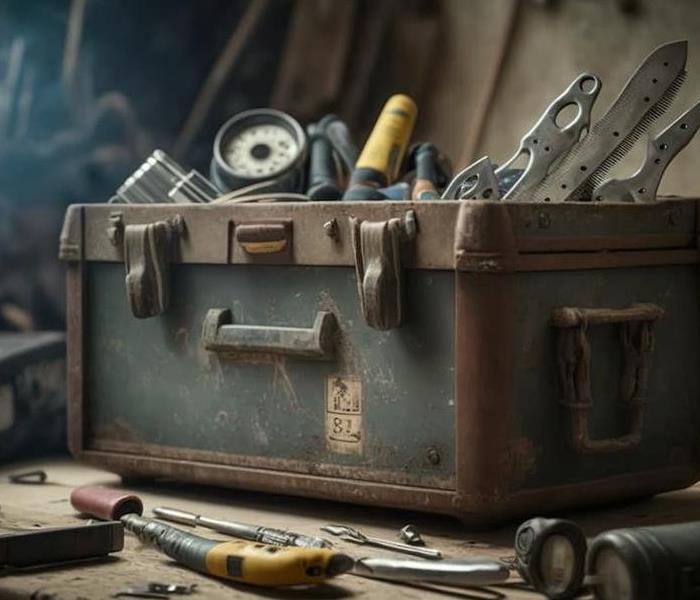 Attempting to use the tools at your own disposal are dangerous for large-scale cleanup efforts.
Attempting to use the tools at your own disposal are dangerous for large-scale cleanup efforts.
Capable of quickly spreading and causing structural damage, fire can be dangerous. When it occurs in your home or business, you are left with damage to property and lives. Even if firefighters put out the fire, the damages still remain. It's best to let the professional take care of the restoration. Here's everything that can go wrong with DIY fire damage restoration:
You May Cause Further Damage
Approaching your property after a fire, it is possible that you may see no structural damage. However, this doesn't mean the damage isn't present. It could be hidden under layers of soot and smoke. Removing these items yourself can cause further damage to the property or create an unsafe environment for those living in the home.
For example, if your kitchen caught on fire and burned down, some rooms in the house will likely remain unscathed. To ensure that all necessary steps have been taken to protect your home, you should board up the unburnt portion, cover broken windows and doors with plywood or other material, turn off water meters on that side of your house, and check for any damage to roofing or flooring due to smoke. A fire can be such an overwhelming and stressful experience for homeowners you may forget and overlook certain precautions. It's crucial to call in experts who know how to mitigate the damage further.
You May Overlook Certain Fire Restoration Practices
Complete restoration of a fire-damaged space requires more than a good scrub. You'll need to employ specific strategies and components unique to the fire restoration process.
For example, smoke and soot are typical by-products of fire damage. Vacuuming can help remove these, but this is simply a surface-level approach. You'll also need to go deeper and clean the air ducts and ventilation systems. There's also the need to remove any residual smoke odor. If left unchecked, both can cause extensive damage to wires and other materials in your home.
You May Create a Dangerous Environment
Fire damage is also a health hazard. You can't just clean up the mess and move on with life. Getting rid of any lingering smoke particles or soot that could trigger respiratory issues or other health problems later on down the road is imperative.
You Could Throw Away Salvageable Items
Go through your things without anyone else's input. Especially if that person is not a professional organizer or someone who can objectively judge whether something should be saved or thrown away—you may decide to get rid of furniture and other household items when it would have been better to repair them.
You should always have a professional inspect your items before making any decisions about whether or not to discard them. A pro can estimate the furniture's worth, how much it would cost to refurbish, and whether it's even worth your time and effort.
You May Be Liable for Damage
You must prove that such a thing occurred to get reimbursement for any losses or damage. Before you start a clean-up or remove any hazardous materials from your property, it is essential to have proof that the products were causing problems.
However, creating a list of your losses after such a traumatic incident can be an exhausting task. You may forget to document critical details, which can result in an inability to claim compensation for your losses.
Why Should You Hire Experts?
The damage caused by fire creates a large and complicated project. Working with professionals ensures that no detail is overlooked and every issue is addressed. Fire damage clean-up and restoration experts have the training, equipment, and experience necessary to clean up the fire's devastation so your home or business looks like it did before or even better.
SERVPRO of South and Northwest Grand Rapids knows fire damage. We have training and expertise in fire damage restoration, so when you call us after a fire, we'll know exactly how to handle your needs. Call us at (616) 662-9700 with any questions or concerns you may have regarding your property or if you would like more information about our services.
The Benefits of Professional Fire Damage Restoration
2/10/2023 (Permalink)
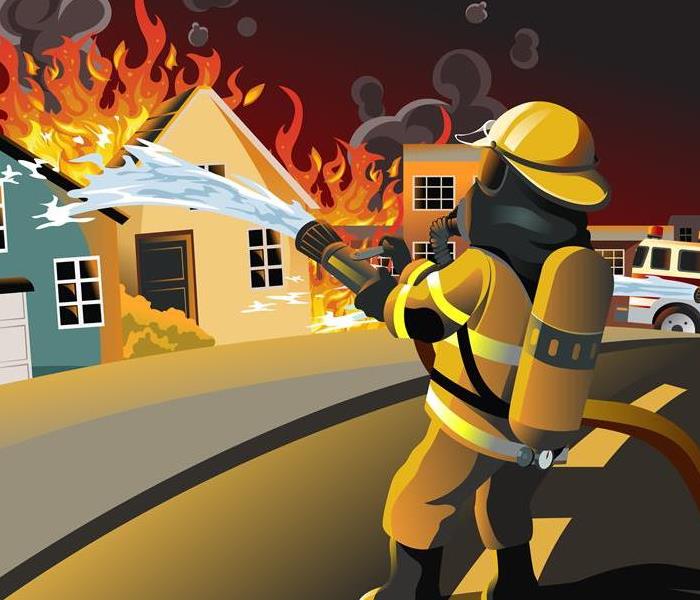 Fires attract two types of professionals. Firefighters and damage restoration experts.
Fires attract two types of professionals. Firefighters and damage restoration experts.
What goes through your head when you think of professional fire damage restoration? For most people, it's going to be negative thoughts. They are going to think about how much time and effort it will take, and many will overlook the benefits of hiring a professional fire damage restoration service.
The truth is that professional fire damage restoration services can be highly beneficial. They have the experience and equipment needed to handle the situation quickly and efficiently, so you don't have to worry about it as much. Here are a few benefits of hiring a professional fire damage restoration service.
Quick Response
Fire damage restoration professionals understand the situation's urgency and respond swiftly to your requests. They have the experience and equipment needed to handle the problem quickly, so you don't have to worry about it as much.
Expertise
Professionals know what to do in case of fire damage, so you don't need to spend hours researching how to handle it. They also understand the importance of following regulations and laws regarding smoke damage from fires, which means they'll also be able to guide you through the process.
After inspecting the damage, trained professionals will create a plan for cleaning and repairing.
Knowledge of Local Regulations
Many businesses have employees licensed in fire restoration techniques and know how to work within local regulations regarding cleaning up after fires caused by electrical or other types of fires. This knowledge can help keep your home compliant with local laws regarding clean-up after a fire has occurred in your home or office space.
They Can Help You Save Your Belongings
Professional fire damage restoration services understand what's essential in your home and can help you save those items. They have the equipment needed to dry out areas quickly without causing damage to the surrounding area. This means that they can help keep mold from spreading throughout your property.
Access to Specialized Equipment
Smoke damage from fires can cause severe damage to your home, including the air ducts. This means that you'll need specialized equipment to clean it up properly. Professionals will have access to this type of equipment, allowing them to get rid of smoke odors more quickly and thoroughly than if they had to rely on household items alone.
These companies have a network of professional cleaning technicians trained to provide high-quality fire damage clean-up services. They will be able to remove smoke, soot, and other debris from your home or business. You can also trust these professionals to dispose of any hazardous materials that may have been released during the fire, such as asbestos or petroleum products.
Help File an Insurance Claim
If your home or business has been damaged by fire, you may need to file an insurance claim. A professional cleaning company will be able to advise you on the steps you need to take when filing an insurance claim for damages caused by a fire.
A professional fire damage clean-up company can help ensure that your claim is processed quickly and efficiently so that you can begin rebuilding your home or business.
Thorough Post-Inspection
A fire damage clean-up company will thoroughly inspect your home or business for any remaining smoke or fire damage after completing the cleaning process. Post-fire clean-up is a complex process that requires specialized equipment, training, and knowledge.
Help Is Available Round the Clock
When disaster strikes, time is of the essence. The professionals at fire damage restoration companies are available 24 hours a day, 7 days a week. They can respond quickly to any situation and control things before the damage worsens.
We at SERVPRO of South and Northwest Grand Rapids share the same commitment to quick response times. We have a team of technicians who are ready to respond 24/7 to any type of fire damage emergency. We can get to your property quickly and start working on the restoration process. Give us a call at (616) 662-9700 with any questions!
The Steps Involved in Fire Damage Restoration
1/26/2023 (Permalink)
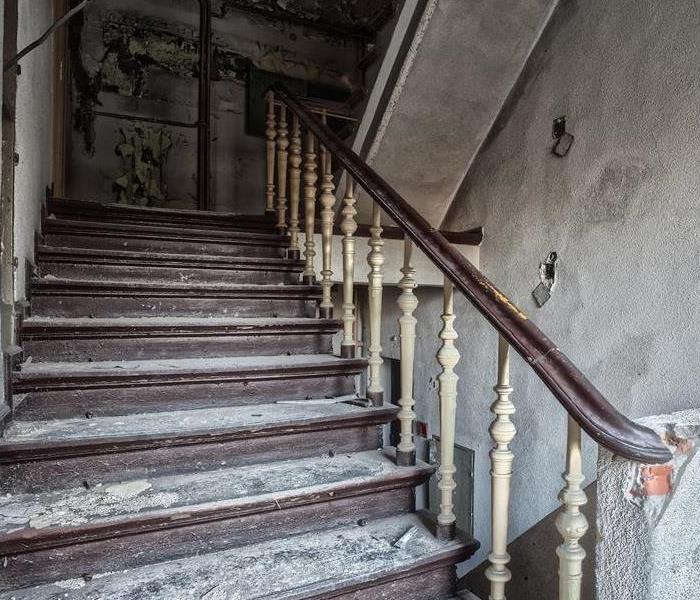 Fire damage cleanup isn't as simple as picking up debris. There's a process that's proven and effective.
Fire damage cleanup isn't as simple as picking up debris. There's a process that's proven and effective.
Fire damage restoration is a process that cannot be rushed. Although the damage caused by fire can be worked on directly, it requires a lot of patience and planning. When it comes to fire damage restoration, understanding the process is essential, which will allow you to decide when professional help should be sought. The following is a rough guide to the process of fire damage restoration.
Step 1: Assessment of Damage
The first step in the fire damage restoration process is to assess the damage. A technician will inspect your property and give an estimate of how much time it will take for the restoration process to be completed, as well as its cost.
Although some homeowners choose to do the renovation themselves, hiring a fire damage restoration company capable of catching problems you might not notice is smart.
Step 2: Isolation
A home should be secured before beginning any renovations to prevent additional damage that might occur due to holes, weakened beams, or other structural problems.
Home renovation experts may reinforce structures and secure open doors, windows, or roofing structures by tarping them. Depending on the property's size, this process may take a few days or extend over weeks.
Step 3: Water Assessment and Removal
In many cases, water is used to extinguish a fire during the course of putting it out. Inspection for water damage and drying the interior of a house may precede cleaning up debris. This can be a delicate process, as water can cause damage to the structure of a house. The home inspector will look for signs of flooding, like standing water in the basement or ground-level floors.
Fire damage restoration companies employ industrial-sized dehumidifiers and air movers to dry your premises. This lowers the chances of mold production and helps to prevent structural damage.
Step 4: Smoke Removal
The longer smoke is allowed to linger, the more damage it can cause. The smoke can cause severe respiratory problems and discoloration of walls and ceilings. Smoke damage restoration is a specialized service that requires special equipment, training, and experience.
It is important to remember that smoke damage restoration is not the same as smoke cleaning. Smoke cleaning involves removing soot from surfaces, while smoke damage restoration involves restoring the damaged areas to their pre-fire condition. It also involves removing odors, which can take some time and effort.
Step 5: Cleaning and Sanitation
After the smoke damage restoration process, it is crucial to thoroughly clean and sanitize the area. This step ensures that no bacteria or mold remains in your home or business. For this step, commercial-grade equipment and the knowledge and expertise to use it properly are required.
Step 6: Repairing and Renovations
After the smoke damage restoration process is complete, it is essential to repair and renovate the damaged areas. This step ensures that your home or business looks as good as new after a fire. You may need help from a professional contractor with this step if the damage is extensive.
Step 7: Preventative Measures
In addition to the above steps, it is essential to take preventative measures to avoid future fires in your home or business. This step can be done on your own by checking smoke detectors and updating any faulty wiring or equipment.
You can also help prevent fires by keeping an eye on your heating system, ensuring that it is properly maintained and inspected by a professional.
Step 8: Claiming Insurance
You should contact your insurance company as soon as possible to file a claim. They will send an adjuster to review the damage and determine how much you are due for reimbursement.
Sometimes, fire damage is hard to spot. Often the people most affected by fire damage are distracted by other things. That's why it's always essential to have a professional look over your property after a fire to help you understand what you're dealing with and what your next step should be. SERVPRO of South and Northwest Grand Rapids is ready to help with any fire damage needs that you may have. To speak with one of our professionals, call us at (616) 662-9700 today.
4 Most Common Causes of a Kitchen Fire
11/28/2022 (Permalink)
 There are many causes of kitchen fires, including burning food, poor electrical outlets, and inattentiveness.
There are many causes of kitchen fires, including burning food, poor electrical outlets, and inattentiveness.
A kitchen can be a dangerous place if you are not cautious. Most of us cook every day in the kitchen and deal with various electrical appliances near a water source and heating elements.
Kitchen fires are usually how a home fire starts, so it can be very alarming when something catches on fire while you just want to fix yourself a meal. Here are the most common causes of kitchen fires so that you're prepared to avoid them.
Most Likely to Cause a Kitchen Fire
Cooking Accidents
Taking your eyes off your food while cooking is not a good idea. Unattended cooking is the leading cause of kitchen fires, accounting for more than half of all home fires.
So, it is important to always stay in the kitchen when you're cooking. If you feel tired or out of it, this is one case when ordering takeout is not only the healthier option but the most responsible one, too.
Electrical Problems
Malfunctioning appliances or faulty wiring are the second leading cause of kitchen fires. Be especially careful with old appliances, as wires can become loose and break.
Electrical fires are especially dangerous because everyone's first instinct when dealing with a fire is to pour water over it. This is a big mistake because water conducts electricity!
The first thing you should do is unplug the appliance if it's plugged in. Then smother the flames with fistfuls of baking soda. If this didn't put out the fire, call emergency services immediately.
Make sure to properly maintain your electrical appliances so that this doesn't happen. A good habit to get into is not to overload circuits with too many appliances plugged in at once.
Candles
Candles are one of the leading causes of house fires, usually because people underestimate the damage they can cause. Lit candles, especially when left unattended, can set fire to the whole house.
Exercise caution with lit candles, especially near flammable materials like curtains or towels. It's also not advisable to put a candle in a drafty spot, like by a vent or a window, on a windy day.
Don't burn a candle for longer than 4 hours, and never leave it unattended. This is especially important if you have children or pets in the house.
Kids Playing with Fire
Adding to the last point, kids often start kitchen fires by playing with matches or lighters they find around the house. A child's natural curiosity can put them at risk.
They're too young to know any better, so it's on the adults to supervise them and teach them about fire safety. Children are usually fascinated by fire, so they won't immediately call out for help if they accidentally cause one.
They associate fire with birthday candles and fireworks and don't realize how scary they can be until they potentially get hurt. They also tend to play with fire in hidden, enclosed places because they may have been told it's wrong. You can see how this can be disastrous.
If you have a child in the house, educate them about fire safety as soon as possible. Teach them about the dangers of fire, and that matches, lighters, and heating elements in the kitchen aren't toys.
Call Fire Damage Professionals
Kitchen fires are scary, but once the damage is done, you'll want your old kitchen back. After all, a kitchen is one of the most useful rooms in a house.
We at SERVPRO have been doing fire damage restoration for years. Call us, and we'll make sure that not the slightest trace of smoke or soot is left in your home. We're available 24/7 to restore your home back to its unblemished state.
Restoring Your Garage after a Fire
9/22/2022 (Permalink)
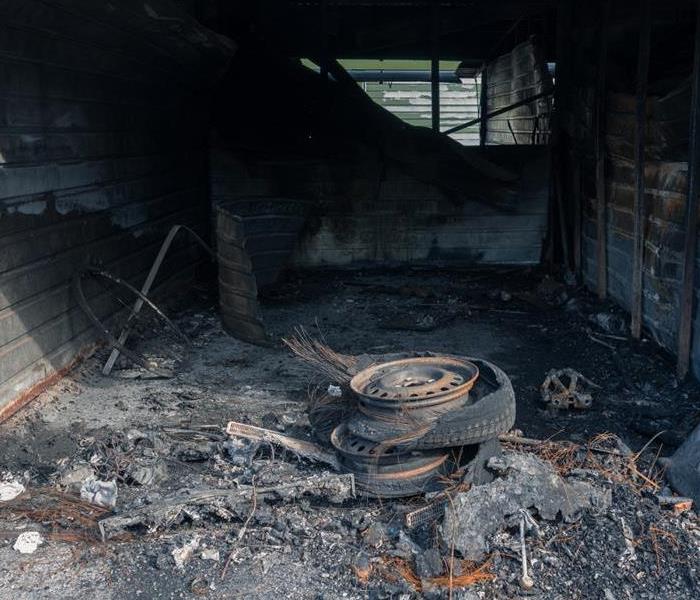 A fire damaged garage can burn everything it the confined space.
A fire damaged garage can burn everything it the confined space.
If your garage catches on fire and is put out, your first steps should be to contact your insurance company and a professional restoration company, like SERVPRO. They can help you assess the damage and begin the process of cleaning and repairing your garage.
Fire damage can be very extensive and can cause a lot of damage in a short period of time. It's important to have a professional assessment done as soon as possible so that the right steps can be taken to restore your garage to its original condition.
How Do You Clean Up Smoke After a Fire?
If your garage has been damaged by a fire, it's important to take the necessary steps to clean up the smoke and soot residue. Smoke and soot can cause a number of respiratory problems and can also damage your belongings.
SERVPRO is a professional cleaning company that specializes in fire and water damage restoration. We can help you clean up the smoke and soot residue from your garage and can also investigate to see if we can restore other damaged parts of the building.
How Do You Clean Fire Damaged Concrete?
If your garage has been damaged by a fire, it's important to clean the concrete as soon as possible. The soot and ashes from the fire can cause the concrete to become stained and discolored.
If you're dealing with a small area of damage, you can clean it yourself using a vacuum cleaner and some detergent. For larger areas, it's best to call in professionals. SERVPRO is a company that specializes in cleaning up after fires and other disasters. They have the equipment and experience necessary to get your garage back to its original condition.
What’s Salvageable After a Garage Fire?
In many cases, items that appear to be destroyed can often be restored with the right techniques and equipment. The professionals at SERVPRO have years of experience in fire damage restoration, and they will work tirelessly to get your garage back to working condition.
How Do You Seal Wood After a Fire?
If your garage has been damaged by a fire, it's important to take action quickly to prevent further damage. One way to do this is by sealing the wood. SERVPRO can help by providing the necessary equipment and expertise to seal the wood and protect your home.
Fire can cause significant damage to wooden surfaces, and in some cases, the fire may have even reached the inside of the wall studs. In order to prevent water damage and additional decay, it's important to seal the wood as soon as possible. SERVPRO can provide a variety of services including content cleaning, pack-out services, and air scrubbing. We also have specialized equipment that can be used to dry out walls and floors quickly.
How Can SERVPRO Help You After a Garage Fire?
Fire can cause significant damage to wooden surfaces, and in some cases, the fire may have even reached the inside of the wall studs. To prevent water damage and additional decay, it's important to seal the wood as soon as possible. SERVPRO can provide a variety of services including content cleaning, pack-out services, and air scrubbing. We also have specialized equipment that can be used to dry out walls and floors quickly. Contact us today to see if we can help.
Cleaning Your Chimney Will Lower a Chance for a Fire
9/22/2022 (Permalink)
Cleaning your chimney annually can help to prevent a fire from happening in your home. By removing the soot and creosote build-up from your chimney, you can help to create a safe environment for yourself and your family. Soot and creosote are highly flammable and can easily ignite, causing a dangerous fire in your home.
Signs of a Chimney Fire
When you see any of the following signs, it means you have a chimney fire and should call your local chimney sweep or fire department immediately.
- There is excessive smoke coming from the chimney.
- You can smell something burning in the house.
- You can see flames or sparks coming from the top of the chimney.
- The bricks around the top of the chimney are cracked or missing.
- The metal liner inside the chimney is damaged or corroded.
Roof Damage Because of a Chimney Fire?
Chimney fires can cause significant damage to a roof. The heat from the fire can warp and melt the roofing material, and the smoke and soot can discolor and corrode the metal flashing around the chimney. In extreme cases, the fire may even cause the chimney to collapse.
If you have a chimney fire, it's important to take steps to prevent further damage to your home. Be sure to call a professional restoration company to assess the damage and help you get your home back to normal.
Puff Back Through the Chimney?
Puff Back is a condition where flammable creosote deposits in a chimney or furnace explode, sending soot and ash spewing into the air. The name comes from the sound of the explosion, which is similar to that of a cannon.
Creosote is a black, tarry substance that forms when wood or coal is burned incompletely. It can accumulate in chimneys and ductwork over time, and if it's heated to the point of combustion, it can cause a Puff Back.
Are Soot and Smoke Inhalation the Same?
The short answer is no, they are not the same. Soot is a black or brown powder that is produced when something burns, such as coal, wood, or oil. Smoke is made up of soot and other particles that are created when something burns. Inhalation of soot can cause health problems such as coughing, difficulty breathing, and chest pain. Inhalation of smoke can also cause health problems, including coughing, difficulty breathing, chest pain, and asthma attacks.
What Happens After a Chimney Fire?
If you experience a chimney fire, the best thing to do is call your insurance company and SERVPRO for fire damage restoration. A professional will come in and assess the damage, clean up the soot and ash, and repair any damages caused by the fire. It's important to act quickly after a chimney fire because the longer the soot and ash sit in your home, the more damage they can cause.
Why Call SERVPRO to Help?
If your home has suffered a chimney fire, it's important to call in the professionals to help get your property back to normal. SERVPRO is one of the leading restoration companies in the country, and they have the experience and expertise necessary to properly deal with the aftermath of a chimney fire.
Chimney fires can cause a lot of damage, not just to your chimney but also to your roof and home interior. The soot and ash from the fire can be extremely corrosive, and can quickly eat away at metal, wood, and other materials. SERVPRO's team of experts will work quickly to clean up the mess and restore your home to its former glory!
Ways to Prepare for a Home Fire
9/20/2022 (Permalink)
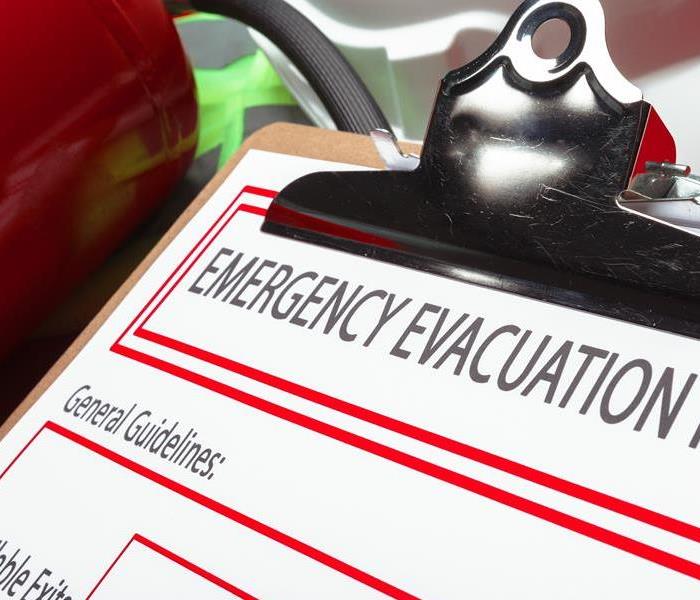 A fire evacuation plan checklist adorned by a fire extinguisher.
A fire evacuation plan checklist adorned by a fire extinguisher.
It is always a good idea to prepare for any home disaster. Compared to other home accidents, fires are the most common. If you aren't well prepared to handle a home fire, you will experience detrimental losses. Develop a concrete plan to deal with a sudden fire breakout to increase your chances of survival. Here is a comprehensive list to prepare your home for fire.
Make an Escape Plan
The foremost aspect of home fires you should address is creating a detailed escape plan. Start with your house or apartment's blueprint. Familiarize yourself with the layout and make a note of all fire escapes, building entrances and exits, doors, corridors, and windows. Understand the fire alarm system of your home and thoroughly understand your building's fire emergency procedures. If you have children and pets, practice fire drills to ensure they aren't lost if a fire breaks. Your escape plan should include a meeting point after exiting the house or building and ensure to stop anyone from entering the building until the fire department comes and extinguishes the fire.
Remember, every second counts in a fire. Escape plans help you get out of your home quickly, so practice your home fire escape plan twice a year at least. A fire can become life-threatening in merely two minutes. A residence can be engulfed in flames in five minutes. When you notice something out of the ordinary, call SERVPRO of South and Northwest Grand Rapids at 616-662-9700.
Understand the Basics of How to Deal with a Fire
Even if you have a comprehensive plan on how to escape a fire, without knowing how to protect yourself, you won't make it far. The fire isn't the only hazard; flames, smoke, collapsed building structures, open electrical circuits, etc., will also get in the way of your escape and can severely harm you. If your clothes catch fire while escaping, stop, drop and roll to put out the flames. Cover your nose and mouth to prevent smoke inhalation if you need to go through smoke-filled corridors. Always stay close to the ground and never run. Navigating spaces with the smoke clouding your vision becomes hard, so staying close to the ground will stop you from tripping or running into things.
Fire Alarms and Smoke Detectors
Fire alarms and smoke detectors are life-saving devices that should always be operational. Install smoke alarms on every floor and in every bedroom of the house. Smoke alarms are meant to be installed onto ceilings since they detect rising smoke. Regularly get them inspected and change the batteries frequently. Do not switch off the low battery alarm. You might forget to change batteries, and the alarms won't go off if a fire happens. If you stay in an apartment, you must know what the fire and evacuation alarms sound like. A home equipped with smoke detectors and fire alarms is more likely to survive a fire than one without.
Fire Extinguishers
Most commercial buildings and apartments have fire extinguishers. If you live in a house, invest in a good fire extinguisher or two. Keep one in your kitchen and have one for each floor if possible. Different class fire extinguishers are available, so familiarize yourself with each rating system. Class A ratings are effective against paper, wood, textiles, and plastics. Class B is effective against flammable liquid fires, and class C is against live electrical fires. Learn to properly operate an extinguisher, including knowing how to remove the pin lock, aim, and release.
A comprehensive plan can determine the outcome of a life-threatening situation. It is never too late to prepare your home for a fire accident, so keep our detailed information at hand when preparing your home for a fire.
Investing in a Commercial Fire Suppression System
4/26/2022 (Permalink)
Fire suppression systems can come in a variety of shapes and sizes, but they are all designed for the same task. Quickly extinguishing a fire is essential to protect and save lives and property. Whereas most homes are equipped only with a smoke alarm, commercial fire protection involves much, much more. The method of fire detection and suppression will differ in each building, so it is important to learn about the types available.
To get started, you should know that there are two categories of fire alarms: automatic fire alarms and manual fire alarms. Every commercial building is required to have at least one fire alarm. An automatic fire alarm works when it detects heat or smoke, and once it does it will send an alert throughout the building to warn those inside. The typical manual fire alarm is the pull station on the wall, where the alarm requires an employee to pull the lever in order to alert the occupants.
Buildings can be equipped with both automatic and manual fire alarms, but the types of suppression systems might vary. One of the most common systems is the commercial fire sprinkler system, which controls and extinguishes flames rapidly by discharging water when the fire’s heat is detected. These are found in commercial buildings like grocery stores, restaurants, retail chains, and distribution centers.
There are a couple different types of sprinkler system, each with a slightly different function, but a similar purpose. A wet-pipe sprinkler system holds water constantly and is ready to spray at any time. Dry powder systems will fill with water only when the system is activated. Deluge systems keep the heads open at all times and will fill with water when activated. Pre-action systems require a supplemental fire detection system to avoid accidental discharge.
However, water and sprinkler systems may not always be the best option. Sprinkler systems should not be used where water cannot put out a fire, like in kitchens, or when water might cause irreparable damage to the building’s contents, like computer rooms or file storage. These areas need a non-water-based system.
Commercial fire suppression systems will suffocate a fire by using chemical, gaseous or foam agents, rather than using water. These systems typically cause minimal damage to expensive equipment, and will even stop chemical-based or grease fires quickly.
To determine whether your commercial buildings need a sprinkler system or a fire suppression system, you need to know what it is inside your building and if a sprinkler system could be harmful in its own way. If you need to be able to protect computers, expensive equipment, important files, or irreplaceable items, it would be wise to install a fire suppression system over a sprinkler system.
Regardless of the type of fire suppression system you choose for your commercial building, know that it is better than nothing at all. Commercial fire suppression systems are important to not only protect your property, but to also save lives.
For more information on commercial fire suppression systems, call SERVPRO of South and Northwest Grand Rapids today at (616) 662-9700. Our specialties include fire, water, and storm damage restoration for residential and commercial clients. We also do mold and mildew remediation and much more.
What Are Some Important Things You Should Know About Cleaning Up Fire Damage In Your Cascade Home?
2/11/2022 (Permalink)
After a fire in your Cascade home, you will want to contact fire damage cleaning professionals to help you recover from its effects. Fire will affect everything in your home or business through the flames, heat, soot, and smoke. The assistance of professionals who have the required expertise and equipment will be vital in getting your living spaces back to normal as soon as possible.
How Will A Fire Restoration Company Like SERVPRO Help Restore My Cascade Location From Fire Damage?
SERVPRO specializes in restoring the contents of a home or business that has suffered from fire damage. The team will assess all your belongings carefully to determine which items can be restored to their “pre-fire” condition and will use several cleaning methods to restore your property to its original condition. These can include:
- Foam. This is used for upholstery. If you use water, upholstery can shrink, and the colors may bleed.
- Dry. This method is used to get rid of light residue.
- Wet. This is a very effective cleaning method that removes moderate to heavy residues.
- Immersion. In this method, items are dipped into a bath of cleaning products for a thorough cleaning that removes heavy residues and overwhelming odors.
What Are Some Ways Smoke Residue Can Affect My Cascade Home And Belongings?
- Fire-damaged electronics and the accompanying smoke often present a serious hazard, so never turn your electronics on after they have been damaged by fire, just to be safe. Smoke residue contains acids that corrode metal and can cause electronic failure in a device. Computers, televisions, and CD/DVD players should be assessed and cleaned by a professional before they are used again.
- Inhaling smoke can immediately negatively affect you, even if it’s only for a short time. With that in mind, don’t enter your home or business until all the smoke is cleared from the premises. Hiring a professional fire and smoke damage restoration contractor will ensure that your property is free from the after-effects of a fire quickly and thoroughly.
- Smoke comprises a complex mixture of gases and fine particles produced when wood and other organic materials burn. Getting smoke residue cleaned up right away after a fire in your Cascade home will be an essential part of protecting your health and safety and that of your loved ones.
If your home or business has suffered damage from fire, water, or mold, here at SERVPRO of South and Northwest Grand Rapids, we have all the training and equipment needed to get your Cascade property back to normal as soon as possible. We are your cleanup and restoration professionals from water damage to odor removal and everything in between. Call us today at (616) 217-3354!
This franchise is independently owned and operated.
How Do I Properly Clean My Sparta Home After A Fire?
11/30/2021 (Permalink)
Contacting a cleaning professional may be the best decision you can make if a fire occurs in your Sparta home. The flames, heat, soot, and smoke will affect every room in your house, and your structure can even be adversely affected. Recovery from a fire event is a tremendous job, so you will need the assistance of professionals who have the expertise and equipment required to get your work or personal space back to normal as soon as possible. Our SERVPRO of South and Northwest Grand Rapids team can be onsite right away to help you begin the recovery process.
What Steps Can I Take While Waiting For SERVPRO of South and Northwest Grand Rapids To Arrive At My Sparta Home?
While you are waiting for SERVPRO of South and Northwest Grand Rapids to arrive, there are some things you can do to begin the cleaning and recovery process:
- Be sure to limit movement in the home to prevent soot particles from being embedded into upholstery and carpets.
- Keep hands clean so as not to further soil upholstery, walls, and woodwork.
- Place clean towels or old linens on rugs, upholstery, and carpet traffic areas.
- If electricity is off, empty freezer and refrigerator and prop doors open.
- Clean and protect chrome with a light coating of petroleum jelly or oil.
- Wash houseplants on both sides of the leaves.
- Change HVAC filter.
- Tape double layers of cheesecloth over air registers.
What Types Of Fire-Related Cleaning and Restoration Services Does SERVPRO of South and Northwest Grand Rapids Offer?
Cleaning Process. SERVPRO specializes in restoring the contents of a home or business that has suffered from fire damage or water damage. The team will assess all your belongings carefully to determine which items can be restored to their “pre-fire” condition and will use several cleaning methods to restore your property to its original condition. These can include:
- Foam. The foam method is used for upholstery since upholstery can shrink, or the colors may bleed in water.
- Dry. This method gets rid of light residue.
- Wet. This technique is a very effective cleaning method used to remove moderate to heavy residues.
- Immersion. In this method, items are dipped into a bath of cleaning products for a thorough cleaning that removes heavy residues and overwhelming odors.
- Electronics. Electronics damaged by fire and the accompanying smoke often present a serious hazard, so never turn on fire-damaged electrical devices. The smoke residue contains acids that corrode metal and can cause electronic failure in an electrical component. Computers, televisions, and CD/DVD players should be assessed and cleaned by a professional before being used.
- Odor Removal. Inhaling smoke can have an immediate negative effect on you, even if it’s only for a short time, so managing lingering soot and smoke is important. Hiring a professional fire and smoke damage restoration contractor will ensure that your property is free from the after-effects of a fire quickly and thoroughly.
- Reconstruction. If the smoke and fire damage to your home or business is such that it will need extensive restoration or rebuilding, SERVPRO can organize your move-out process. Removing your items from designated areas will help any remodeling process go a lot faster and protect them from any further damage. Once that is complete, we can then coordinate and organize your move back into your premises to get back to normal.
If your Sparta home or business has suffered damage from fire, water, or mold, SERVPRO of South & Northwest Grand Rapids team is fire damage and water damage experts, and we handle mold remediation, too. As part of our fire restoration services, we remove all unpleasant fire-related odors, as well.
We can get your home or business Certified: SERVPRO Cleaned. This franchise is independently owned and operated.
What Is The Proper Way To Use A Fire Extinguisher?
9/21/2021 (Permalink)
You may never have used a fire extinguisher before, and it can be a little daunting even to consider. When it comes to fire safety, it’s better to be safe than sorry, however! The time to learn how to handle a fire extinguisher is when there is no emergency, giving you time to think about what you are doing and practice the steps. Being proactive by learning this critical skill in advance of a fire emergency is one smart way to guard the safety of your Byron Center home or business.
Below you will find the steps to follow for the proper use of a fire extinguisher, as well as some further information to help you:
What Are The Correct Steps To Take When Using My Fire Extinguisher To Protect My Byron Center Property?
The P.A.S.S. method is the most highly recommended method to use when handling a fire extinguisher:
- Pull the pin on the extinguisher.
- Aim the hose nozzle low toward the base of the fire.
- Squeeze the handle to release the extinguishing agent.
- Sweep the nozzle from side to side at the base of the flames until extinguished.
What More Do I Need To Know About Handling A Fire At My Byron Center Property?
Knowing how to operate the extinguisher is not all you need to understand. Responders to fire also should be able to adhere to the following protocol:
- Sound the fire alarm or call the fire department immediately.
- Before approaching the fire, determine an evacuation route away from flames, excessive heat, and smoke, and keep this evacuation route from being blocked.
- Use the P.A.S.S. technique for discharging an extinguisher and back away from the area if the fire flares up again.
- If the extinguisher is empty and the fire is not out, evacuate immediately.
- If the fire grows beyond what you can handle safely, evacuate immediately.
According to O.S.H.A., the most common emergency small businesses need to plan for is fire. O.S.H.A. requires employers to thoroughly train workers on an annual basis at minimum how to use an extinguisher properly and assess a situation accurately to determine when evacuation is the safest course of action.
You can find more fire extinguisher information here.
When it comes to damage from fire, water, or any other disaster of any size SERVPRO of South and Northwest Grand Rapids is here to help! In addition to fire damage, we handle many other kinds of issues, such as mold remediation and commercial cleaning.
We can get your home or business Certified: SERVPRO Cleaned!
This franchise is Independently Owned and Operated.
Maintaining Your Smoke Detectors
7/13/2021 (Permalink)
Smoke detectors are not something we pay much attention to during our day-to-day living, but they immediately become essential if a fire happens! Make it a priority to maintain your smoke detectors regularly so that they are always ready to alert you in the event of a fire.
Making Sure Your Smoke Detectors Work As They Should
- Make sure you know how old your alarms are, and test them monthly using the provided test button.
- Keep them clean and free of greasy build-up and dust, which could affect their performance. A scheduled cleaning will make sure your smoke detectors stay in good working order.
- Ensure that your smoke detectors are powered up and ready to go at all times and schedule battery changes so that they are always prepared to alert you whenever you need them.
- Your smoke detectors should all go off simultaneously in the event of a fire, so contact a professional to make sure they are all synced.
- Replace all smoke detectors, including those using 10-year batteries and hard-wired alarms, before turning ten years old. If they don’t respond correctly during a routine check, it’s definitely time for new units.
- Save and follow the manufacturer’s instructions for testing and maintenance of your units.
- A certified inspection entity should mark your smoke detectors.
Install Smoke Detectors In All The Right Places
- Every room in your home or business needs a smoke detector, any place where people will be, and where a product is stored, as well.
- Each unit should be securely fastened to its surface, whether it is a wall or a ceiling.
- Ensure that smoke detectors are in all areas where people spend time, from the bathroom to the warehouse of your business, and remember that customer waiting areas and public restrooms need to be outfitted, as well.
We care about your safety here at SERVPRO of South/Northwest Grand Rapids, so don’t hesitate to contact us for all your large-scale cleanup projects. We’re experts at handling water and fire damage, mold prevention and remediation, vandalism, and biohazards. Ask us how we can get your home or business Certified: SERVPRO Cleaned. This franchise is independently owned and operated.
Top 3 Fire Hazards In Your Home
5/12/2021 (Permalink)
House fires cause injury, property damage, and death throughout the nation every year. Being aware of the biggest hazards could help you keep your loved ones safe from the results of a house fire, and help you avoid the costs associated with recovering from that kind of disastrous event.
Here are the top 3 fire hazards in your home to be aware of (plus some safety tips to help you manage them):
CANDLES
It’s never wise to light a candle and leave the room. Research has found that there is an average of 10,000-plus fires in the U.S. started by candles every year; that’s an average of 29 candle fires per day! Additionally, one-third of these fires were found to have started in bedrooms, and half of those incidents were due to fires from candles that were left too close to flammable items.
SERVPRO Safety tips:
- Never leave a candle burning near flammable items, and extinguish all candles before leaving the room.
- Never leave a candle burning in a child’s room or an unoccupied room.
- Make sure candles fit securely into candle holders to avoid accidents from tipping.
SMOKING
The number of fires caused by smoking is trending downward, but The National Fire Protection Association reports that there are still currently an average of over 17,000 smoking-related fires per year! This agency also shares that even though the number of smoking-material-related fires has dropped in the last few years due to a decline in smoking, it is still a major culprit. Especially among older people, who are at higher risk.
SERVPRO Safety tips:
- Smoke outside whenever possible.
- Look for cigarette butts under furniture and between seat cushions for those that might not have been extinguished.
- Never smoke when you’re tired or around medical oxygen, or in bed.
ELECTRICAL/LIGHTING
Electrical fires can be caused by an equipment malfunction due to an overloaded circuit, a bad extension cord, an overheated light bulb, or various types of home appliances.
SERVPRO Safety tips:
- Don’t overload outlets or electrical cords.
- Ensure you use the right cord for the job; use inside cords for inside and heavy-duty/outside cords outdoors.
- Don’t leave Christmas lights, Christmas trees, or halogen lights on overnight or when gone from your home.
- Schedule an electrician to come and perform an annual checkup of your home’s wiring.
These are the top three fire hazards you need to be aware of in your home, but there are other fire hazards to guard against, as well. SERVPRO of South and Northwest Grand Rapids is always available to come to your home and conduct an assessment of your fire safety practices. We are proud to serve our community in the restoration of homes and businesses when damage happens from fire, water, accidents, vandalism, biohazards, and more. We can get your home or business Certified: SERVPRO Cleaned, too. This franchise is independently owned and operated.
Bonfire Safety Tips
2/23/2021 (Permalink)
Cold weather is ideal for bonfires, and it is an activity that many people enjoy during the colder months. You may be planning a barbecue or a bonfire party, and we know you and your guests will have an awesome time, but we also know that accidents can happen if good safety practices are not observed at these types of events. With that in mind, we are going to share some bonfire safety tips with you today so that you can be sure that your event is memorable for all the right reasons.
Never Leave Bonfire Unattended
Most bonfire accidents happen quickly, so don’t step away from the fire for even a few minutes. Keep a bucket of dirt or a hose nearby to deal with any incidents immediately. Being vigilant will let you address any problems before severe fire damage happens. We recommend that you wear hard-soled shoes around the fire, too, for protection from flying sparks.
Build In A Safe Location
Choose a location well removed from any flammable materials. Prepare a patch of bare dirt, dig a small depression, and surround the perimeter of your fire with stones; these steps will prevent your bonfire from spreading unexpectedly. Make sure there are no dry grasses, trees, shrubs, fences, sheds, cables, or wires around or above the bonfire.
Choose Proper Materials
An ideal bonfire should be built only from wood, charcoal, paper, sticks, and other organic materials, and you should never use accelerants like lighter fluid or gasoline on the fire. These can cause the bonfire to quickly spread and even to explode. Once the fire is going, avoid throwing batteries, fireworks, and other combustible materials into the fire, and don’t burn items such as tires, furniture, or other things that are man-made, since the materials used in their construction can be toxic when burned.
Extinguish Fire Properly
Even when a bonfire burns down, it still contains a lot of heat. Many fire damage incidents happen because a smoldering bonfire reignites long after everyone is gone. To put a fire out properly, spread the ashes out with a rake or shovel to let them cool, and gently pour water over the ashes until no burning or hot areas are left. If the fire is properly put out, you will not feel any heat if you extend your hand over the area above it.
If you experience damage from fire, water, or a weather event, keep in mind that the team here at SERVPRO of South and Northwest Grand Rapids is ready to help at a moment’s notice. We are disaster restoration experts, and we have all the skills and tools necessary for mold prevention and remediation, too.
This SERVPRO franchise is independently owned and operated.
Fire Damage Restoration - It Takes A Tribe...
12/29/2020 (Permalink)
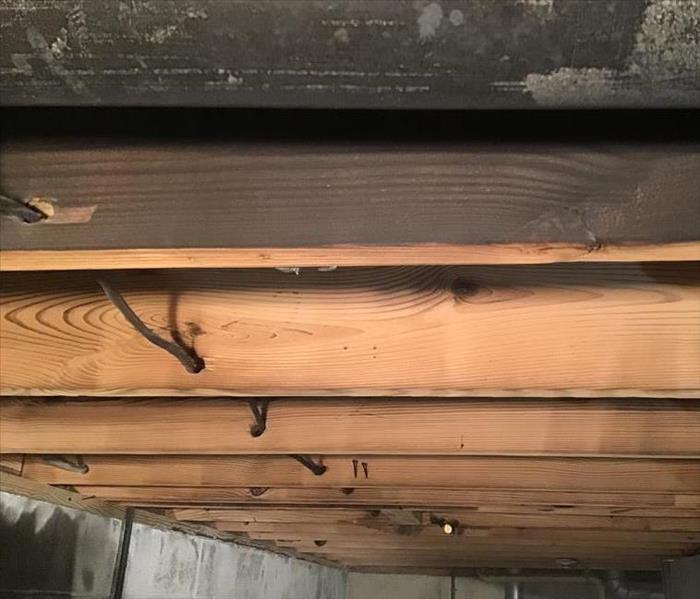 Our SERVPRO crew members were able to make this Grand Rapids basement like new. Fire damage clean up is something we know and do well.
Our SERVPRO crew members were able to make this Grand Rapids basement like new. Fire damage clean up is something we know and do well.
A flood of questions and emotions can overwhelm those that experience a fire at their home or business. Most people do not have extensive experience with fire damage clean up. So it is no surprise that questions such as these create stress and anxiety:
What items are going to be replaced?What irreplaceable heirlooms can be restored?Is the structure safe to enter?Should I submit an insurance claim?What will my insurance cover?How long will all of this take?It takes a team, or tribe, of professionals to properly advise on questions such as those above. The answers (or lack thereof) to these questions are what fuel the emotions. Stress, sadness, and concern will likely all be present but with the right team on your side hope, relief and confidence will come through as well.
Key Players
Insurance Agent -
Insurance agents are often underestimated and underutilized. Developing a relationship with a local agent begins with tailoring a policy that fits your needs and understanding what makes it special for your circumstances. If your agent is not detail oriented when the policy is being developed, they will not likely be a good advisor when something happens.
Your local agent should also have a wealth of information on what types of rulings the local adjusters tend to be more lenient or stringent on and what vendors do good work. When in doubt, call your insurance agent before putting in a claim. They can save you a lot of money by advising a course of action based on how your policy is constructed.
Restoration Team -
It is crucial that you are working with a company that restores, as opposed to a company that just tosses and rebuilds. As mentioned earlier, a good restoration company knows that certain things simply cannot be replaced, items that hold significant sentimental value. Like anything else in life, experience hones skill; choose a company like SERVPRO of South and Northwest Grand Rapids that has daily experience bringing cherished possessions back to life.
Another major point to take into consideration is that every insurance policy has limits. Restoring (if possible) often costs less and takes less time than tearing out structural materials and replacing them. See the picture for an excellent example of this very point. The structure is solid, will be cleaned, and no smoke odor will be present once the job is completed; all in less time that rebuilding.
If you or someone you know experiences a fire, help is available and a team is ready to come to your aid. Work with your insurance agent and SERVPRO of South and Northwest Grand Rapids.
Space Heater Safety Tips
11/18/2020 (Permalink)
Many of us will be using space heaters to help keep our homes or businesses warm in those hard-to-heat corners and drafty areas. These units can be dangerous, however. Space heaters are high-wattage appliances and do have the potential to cause fires if they are not used correctly. We would like to share some space heater safety tips today to help keep you and those you care about safe:
If you are purchasing a new space heater:
- Make sure that any heater you consider is listed by a qualified testing laboratory.
- Only purchase one with a sensor that will shut it off automatically if it overheats or gets tipped over if at all possible.
- Inspect heaters and their cords and plugs. Do not purchase one if you think it could be defective.
Setting up your space heater:
- Ensure your heater is settled on a solid flat surface, and that it’s at least 3 feet from anything flammable. If it is being used in a garage or workshop, keep it away from any paint, oil, and gas cans.
- Never place the heater on furniture or cover it up, and be careful of high-traffic areas and doorways; someone could trip over it or the cord and get burned. Never run a power cord under carpets, rugs, or furniture.
- Plug your heater into an outlet directly rather than using an extension cord or power strip, and ensure that the plug fits well and is the only plug in the outlet.
- Always keep your heater away from water, and if you’re wet, stay away.
When your space heater is in use:
- Check your heater regularly during its use to make sure that the plug, cord, outlet, or faceplate isn’t hot. If it is, turn it off immediately; a hot cord may mean it is defective and could ignite a fire.
- Don’t run your heater 24/7. These units aren’t made to work for long periods of time.
- Never leave a space heater unattended or in a child’s room, and turn it off while you are sleeping.
- Install smoke detectors in your home, as well as carbon monoxide alarms and ensure they are tested monthly.
We hope these best practice tips will help you to use your space heater properly. Here at SERVPRO of South and Northwest Grand Rapids, we want you, your family, and your friends to be safe this winter. If you do experience damage to your home or property, we’re here to help, We are also specialists when it comes to fire damage or water damage, and mold remediation is one of our specialties. We can get your home or business Certified: SERVPRO Cleaned if you need it, so ask us how.
Fire Prevention In Your Commercial Kitchen
9/8/2020 (Permalink)
As the owner or manager of a restaurant and commercial kitchen, you know that fire is one of the worst things imaginable. It will greatly endanger the lives of your staff and your guests and destroy your property, putting you out of business for who knows how long.
Here are some essential fire damage prevention tips for your commercial kitchen:
Faulty cooking equipment is often responsible for restaurant building fires. All your equipment must be maintained in top condition, from ovens to fryers, and your staff should be following established cleaning practices daily, and to the letter, so that everything is in the best shape possible. Regular professional inspections will also ensure that repairs are made before a fire event takes place.
Grease buildup in stove-hoods and grease traps can be a dangerous thing in your commercial kitchen. These equipment components operate under high heat constantly, so they can easily become a fire hazard; kitchen ductwork is at risk, as well. Contact an experienced cleaning and restoration professional to address these issues and help you to maintain healthy indoor air quality.
A critical component of your commercial kitchen fire safety is your fire sprinkler system. Have them regularly inspected as a best safety practice in preventing fire damage; corrosion will definitely affect their performance.
If you don’t know how old your kitchen UL suppression system is, make sure you verify that information during your next inspection. You may want to consider an upgrade to UL 300 compliance to help support your commercial kitchen’s safety.
The very best equipment and the most top quality maintenance can never completely prevent restaurant fires, and the most effective weapon in your arsenal is going to be your employees. Train them to always be ready for restaurant fire emergencies through monthly meetings and drills, and always encourage their input when addressing safety issues. Make sure everyone that is comfortable with fire extinguishers knows how to use them, and ensure that everyone knows how to safely evacuate your building.
Getting you back to business soon is our primary focus. We are always ready here at SERVPRO of South and Northwest Grand Rapids, so call us if you experience fire damage, water damage, or mold issues. We can get your home or business Certified: SERVPRO Cleaned, too.
Fireworks Safety
7/2/2020 (Permalink)
Everyone loves the Fourth of July, and there are so many different reasons to love this holiday: the fireworks, the food and drink, the friends, the fun, and the celebration of our freedom as Americans. This year will be even more special as we move into the months following a tough time for our country, too.
Here at SERVPRO of South and Northwest Grand Rapids, we want to make sure that you enjoy your Independence Day festivities to the fullest, so we wanted to take this opportunity to share some safety tips with you to help ensure you and your loved ones are safe during all the fun.
Here are some best practices for your fireworks safety:
- Obey all local laws regarding the use of fireworks.
- Read the cautionary labels on all your fireworks, and make sure you understand all the performance descriptions before igniting.
- A responsible adult should supervise all firework activities, and he or she should make sure no one gives fireworks to children.
- Alcohol and fireworks do not mix, so please save your alcohol for after the show.
- Wear safety glasses when shooting off your fireworks.
- Light only one firework at a time and then quickly move away from them.
- Use fireworks outside in a clear area and far away from buildings and vehicles.
- Always have a bucket of water or properly functioning water hose nearby during the time that you are firing off your fireworks.
- Never relight a firework that didn’t fire properly, and wait for about 20 minutes for it to cool off, then soak in your bucket of water.
- Never carry fireworks in your pocket or shoot them into any containers made of metal or glass; they could explode and send dangerous shards into your audience.
- Never experiment with homemade fireworks.
- Dispose of spent fireworks by wetting them down and placing them a metal trash can away from any building or combustible materials until the next day.
- FAA regulations prohibit the possession and transportation of fireworks in your checked baggage or carry-on luggage, so don’t try to fly with them.
- Report illegal explosives, like M-80s and quarter sticks, to the fire or police department.
It’s important that you and all your loved ones are safe while you are having fun. If you do experience a fire, call us here at SERVPRO of South and Northwest Grand Rapids for help with any damage that may occur. We also handle water damage, large and small-scale cleanup, and mold prevention/remediation. We are your go-to restoration resource.
You Can Run, But You Can't Hide - Smoke and Soot
7/1/2020 (Permalink)
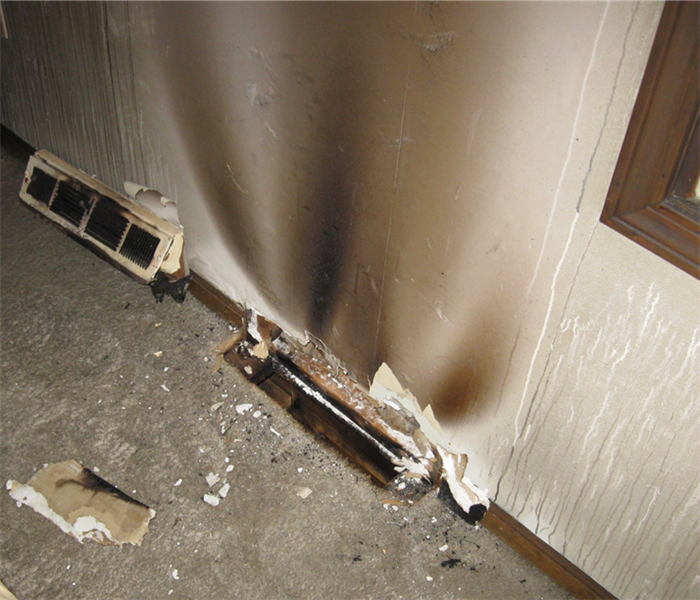 The fire itself remained primarily in the basement, however it is easy to see how smoke and soot will find the path of least resistance to spread
The fire itself remained primarily in the basement, however it is easy to see how smoke and soot will find the path of least resistance to spread
Smoke and soot are very invasive and can affect areas within your home or business that you never imagined would be affected, causing hidden damage and odor. Our extensive knowledge of smoke damage allows us to inspect and accurately assess the extent of the damage to develop a comprehensive plan of action.
Here are the facts:
- Hot smoke migrates to cooler areas and upper levels of a structure.
- Smoke flows around plumbing systems, seeping through the holes used by pipes to go from floor to floor.
- Smoke can make its way into a closed drawer in a room with a closed door on the other side of a home.
- The type of smoke may greatly affect the restoration process.
Different Types of Smoke
There are two different types of smoke–wet and dry. As a result, there are different types of soot residue after a fire. Before restoration begins, SERVPRO of South and Northwest Grand Rapids, will test the soot to determine which type of smoke damage occurred. The cleaning procedures will then be based on the information identified during pretesting.
Wet Smoke – Plastic and Rubber
- Low heat, smoldering, pungent odor, sticky, smeary. Smoke webs are more difficult to clean.
Dry Smoke – Paper and Wood
- Fast burning, high temperatures, heat rises therefore smoke rises.
Protein Fire Residue – Produced by evaporation of material rather than from a fire
- Virtually invisible, discolors paints and varnishes, extreme pungent odor.
Our Fire Damage Restoration Services
Every fire and associated soot situation is different; each one requires a unique solution tailored for the specific conditions. We have the equipment, expertise, and experience to address your fire and smoke damage to effectively restore you home or business. Our trained crews will treat you with empathy and respect and your property with care.
Have Questions about Fire, Smoke, or Soot Damage?
Call Us Today – 616-662-9700
How To Reduce Fire Hazards As We Head Into Summer
5/19/2020 (Permalink)
As we head into the summer season, we want to talk about possible fire hazards that you may face during the warmer months. You’ll be outdoors more often, and between all the cookouts and the heavier use of your HVAC system, in addition to using your landscaping machinery, your home and business property are both at a higher risk for damage from fires.
Here are a few tips to help you reduce fire hazards in the months to come:
- Care For Your HVAC. Dust can settle on electrical components of these units, and this can cause tracking faults which may lead to a fire. Keeping your HVAC clean from dusty conditions is one way to prevent a fire as we head into summer. Having it inspected by a professional to ensure that all moving parts and wiring are in good working order is also a good idea.
- Clean Exhaust Fans. Clean out exhaust fans regularly and take all debris out of the vents. Try to avoid running these fans for long periods of time on a consistent basis, as well, to avoid burning out moving parts.
- Service You Lawn Mower. Follow the manufacturer’s recommended maintenance and care schedule on your mowing equipment, and remember to remove debris and grass clippings from the cutting units, mufflers, and engines on a routine basis. Also, remember to never refuel your mower when it is overheated.
- Store Fuel Properly. You will be using fuel for mowers and grills during the warmer months and may have to store propane or gasoline. The risk from fire is heightened by high ambient temperatures and relief valves that open at pressures that are too low. Always store your gas cylinders upright and always out of doors.
- Be Safe While Grilling. Make sure your grill is stored away from your buildings, as well as overhanging branches. Always maintain a safe zone of at least three feet around the grill, and regularly remove any grease or gas buildup from the grills and trays. Never leave your grill unattended under any circumstances.
- Perform Alarm Audits. Fire prevention should always include fire alarm tests. Be sure to replace any old or burned out batteries regularly.
Here at SERVPRO of South and Northwest Grand Rapids, we care about your safety and the safety of those you love. If you have experienced damages from a fire, or from water or flooding, we’re here to help and can be there right away! We are experts in cleanups from all kinds of disasters, both large and small, and we are mold prevention and remediation specialists, too.
Cleaning Up After Smoke Damage
2/25/2020 (Permalink)
Fire and the accompanying smoke and soot affects everything in your home or business and will include the structure itself, equipment, and belongings. After a fire, contacting a cleaning professional may be the best decision you can make. You will need the assistance of professionals who have the expertise and equipment necessary to get your work or personal space back to normal as soon as possible.
Inhaling smoke, even for a short time, can have an immediate negative effect on anyone, so avoiding a smoky situation is vital. You will want to avoid entering your home or business until all the smoke is cleared from your premises. Hiring a professional fire and smoke damage restoration contractor will ensure that you experience a speedy and expedient return to normalcy.
SERVPRO specializes in restoring the contents of a home or business that have suffered from fire damage or water damage. They will assess all your belongings carefully to determine what items can be restored to their “pre-fire” condition. A professional cleaning company will use several methods to restore your property to its original condition, such as;
- Foam cleaning: used for upholstery, since it can shrink or bleed when water is used.
- Dry cleaning: used to clean light residue.
- Wet cleaning: a very effective cleaning method used to remove moderate to heavy residues.
- Immersion cleaning: items are dipped into a bath of cleaning products.
Electronics that have been damaged by fire and smoke often present a serious hazard. To maintain safety, never attempt to turn on or operate any electrical device that could possibly have been affected. Smoke residue contains acids that corrode metal and that can cause electronic failure in a device. Items that you should be careful of are:
- Computers
- Televisions
- CD and DVD Players
SERVPRO technicians are experienced in document and photograph restoration and can help in the event that your important records or personal keepsakes have been damaged during a fire.
If the damage to your home or business is such that it will need extensive restoration or cleaning, SERVPRO can organize an efficient move-out process of the affected areas. Removing your items from the area will aid in a quicker remodeling process and will protect your items from any further potential damage. After the restoration is complete, move-in can be coordinated easily.
If your home or business has suffered damage from fire, water, or mold, the members of the team here at SERVPRO of South and North West Grand Rapids are fire and water damage experts, and we maintain the training and equipment necessary to help our customers get back to normal after a fire event as soon as possible.
Preventing Fires From Space Heaters
12/17/2019 (Permalink)
Almost half of all fires in homes across the country are caused by the use of space heaters, and an even larger amount of associated deaths from those fires happened because those space heaters weren’t handled correctly. This data is related to the misuse of electric space heaters, specifically; these heaters don’t use fuel so they aren’t vented to the outside of the home. Their proper use is important to keep you and your family safe. With that in mind, we are going to share some tips today that will prevent fires caused by the use of space heaters:
- Be Informed. Read your manufacturer’s information when you first purchase your space heater and make sure you understand how the heater works. Go over the warnings with your family so that everyone knows how to use the unit properly. Make sure the space heater is labeled by an approved entity.
- Be Aware. Your space heater is only intended for use in providing your home with supplemental heat and not as the primary source of heat for any part of the home. They must be kept at least three feet away from other objects. Data shows that this one issue is the main cause of many of the fires we talked about earlier!
- Be Careful. Never leave a space heater unattended - turn off the heat if you are leaving the area, and don’t leave children or pets alone with the unit. Make sure your smoke alarms are installed and working correctly and keep combustible materials away from your heater. The unit should only be placed on a flat floor rather than carpet, furniture, or tables, and away from foot traffic. Plug your space heater directly into the wall, not by an extension cord.
- Be Smart. Don’t use a space heater in damp or wet areas, such as your bathroom or kitchen. You may be able to purchase a safety plug for this purpose from some manufacturers.
- Be Proactive. Inspect your power cord often, looking for frayed insulation or exposed wires. Also, make sure your plug is in good condition. You might want to purchase a heater with a built-in heat sensor that will turn your unit off if it gets too hot.
Here at SERVPRO of Northwest/South Grand Rapids, we care about you and your family’s safety. We can be there to help with any size disaster right away, and we are experts in fire damage, as well as damage from flooding. If you experience a fire event, call us right away!
Fall Fire Prevention Tips
10/8/2019 (Permalink)
With the cooler temperatures of fall just around the corner, it is a good idea to revisit fire prevention and safety tips that are specific to this time of year. As you focus more and more on staying warm, you’ll also want to focus on staying safe while enjoying this season.
- Checkups. Your smoke detectors and carbon monoxide detectors will need a change of batteries so they can stay on duty. Take a look at your fire extinguishers to ensure they are fully charged and in good working order.
- HVAC. Call your local certified HVAC technician and have them come clean, inspect and service your central heating system to avoid potential issues.
- Space heaters. Practice safety when using space heaters by:
- Making sure any unit is surrounded by at least three feet of empty space
- Never using these units to dry clothing or other objects
- Keep any space heater away from furniture or drapery
- Always turn these units off when you go to bed or leave the house
- Fireplaces. Practice fireplace safety using these tips:
- Your chimney should be inspected yearly
- Employ a certified chimney sweep to clean your chimney in early fall, every year
- Repair all cracks in your fireplace
- Use screens to keep sparks and debris inside your fireplace
- NEVER use gasoline to start a fire in your fireplace
- NEVER leave your fire unattended
- Store any combustible materials at least three feet away from the fireplace
- Holiday decorations. Enjoy the holidays safely by taking these precautions:
- Use flashlights instead of burning candles in your Jack-O-Lanterns
- Halloween costumes should be constructed with fire-retardant materials, as should all holiday decorations.
- Make sure that all extension cords and holiday lights have been tested by an approved organization - pay attention to labeling.
- Teach your family fire safety:
- Make sure even young children know how to call 911.
- Establish a fire escape plan for your family, and practice it until everyone is sure they know what to do, and where to meet.
- “Stop, drop, and roll” needs to be taught to everyone and practiced.
- Outdoor fire safety for fall:
- Clear your rain gutters and roof of debris buildup
- Find the outdoor burning regulations for your area, and never illegally burn leaves or other outdoor debris
Here at SERVPRO of Northwest/South Grand Rapids, we care about the safety of your family. Call us for help with fire or water damage, or when you are experiencing issues with mold or mildew. We’re always here to help.
How to Clean Up Smoke Damage in Your Home
7/31/2019 (Permalink)
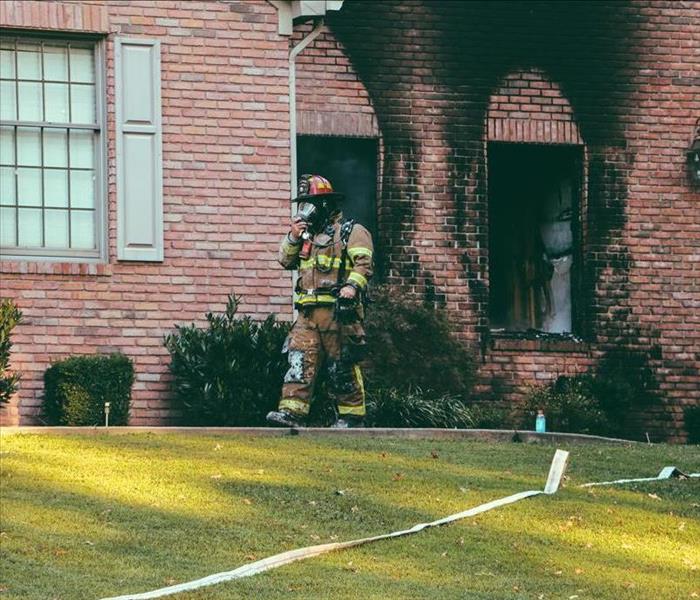 Enjoy a smoke-free home!
Enjoy a smoke-free home!
Cleaning up smoke damage in your home is extremely important, but unfortunately, it won’t be as easy as opening a window and letting things air out. The acidic nature of smoke and soot makes them difficult to remove. However, they both contain unpleasant odors and particles that are harmful to breathe, so it’s important to clean them up completely to maintain a healthy living environment. Here at SERVPRO of South and North West Grand Rapids, we have years of fire damage clean-up experience, and over the years, we’ve picked up a few helpful tips that we’re sharing today:
What You’ll Need
One item you may have to buy is a dry-cleaning sponge, but many other helpful cleaning products can probably be found around your home. A sponge, however, is very important for smoke damage removal, so we encourage you not to neglect adding this effective cleaning tool to your list of supplies. We recommend you acquire the following:
- Rubbing alcohol/paint thinner
- Vinegar
- Degreaser / commercial soot remover
- Vacuum (ideally a strong shop-vac) with an upholstery attachment
- Bucket / hot water
- Dry-cleaning sponge (chemical sponge)
- Clean rags
- Sponge
- Fan
After obtaining the cleaning tools above, here are a few next steps:
Ventilate. The first thing you need to do is ventilate the house to get fresh air flowing; be sure to open all the doors and windows in the home. You also can use fans to encourage airflow. Additionally, turn off your HVAC system to prevent smoke and soot from spreading.
Use Protection. Before you clean your house, make sure to protect yourself properly. Soot, smoke, and debris can be dangerous to inhale, so wear a respirator if there is significant soot in the damaged area. Long pants and sleeves will protect your skin, and wearing gloves and eye protection can help save your eyes and hands. Since you will be freeing soot as you clean, it’s important to lay down floor protection and remove any furniture or household objects that are not damaged. If the damaged area is small, you can simply cover furniture with plastic or sheets, but if you’re cleaning an entire room, it’s wise to remove clean items and even seal off other rooms that were not affected. Be mindful of the shoes you’re wearing so you don’t track soot stains into other rooms.
Vacuum It Up. Soot and smoke damage usually come in one ugly, smelly package, so remove loose soot particles with a vacuum with an upholstery attachment. A shop-vac with strong suction power is best for this task. Lightly brush the affected area with the brush attachment, vacuuming up the loose particles. Be gentle and avoid scrubbing, which can make stains worse.
Use The Sponge. After performing the steps above, it’s time to use that dry-cleaning sponge (chemical sponge) to wipe up the soot and smoke stains; these sponges use special chemicals to lift stains from walls. Never use soot cleaner or water before you use a dry-cleaning sponge or you could spread the soot, making it impossible to remove with a chemical sponge. Begin by wiping the walls gently with the dry-cleaning sponge, and turn the sponge to a different side as it gets soiled so that you are always using a clean surface. When all sides are soiled, slice off the dirty sides with a knife to reveal fresh surfaces beneath, or use a new sponge. Make sure you use a wiping motion the entire time because when you scrub the stains, you spread them and work the soot deeper into the surface.
Use Liquid Cleaners. After you remove as much soot as possible with the dry-cleaning sponge, you can use commercial soot/smoke remover (follow the manufacturer’s directions), rubbing alcohol, white vinegar or paint thinner and a clean rag. Soak the rag in your preferred cleaner and wipe the walls throughout the damaged room. Even if there is no sign of soot or smoke damage, it’s important to wipe every surface in the room, including light bulbs. Next, you’ll want to use TSP, dish soap or degreaser in a gallon of hot water to wash the walls with a rag or sponge; just a few teaspoons should be enough. Use the same wiping motion you used with the dry-cleaning sponge. You may need to use a combination or repeated treatments of these chemical cleaners depending on how bad the damage is. As the rag gets dirty, rinse it out in the bucket or use a new rag. The same applies to your cleaning water. Refresh your water when it gets black or smells like smoke. Once you’ve completed washing the room with your chosen cleaner, wipe the walls again with fresh water and a clean rag to remove any remaining cleaning products.
Dry It Up. Dry the clean surfaces with a clean rag. You can use fans to speed this process up if necessary. You will probably still smell smoke odors, as they can take a few days to a few weeks to dissipate. Identify materials that can easily absorb odors, such as upholstered furniture or area rugs, and place these items together in a separate room or outdoors to see if the smell dissipates after a few days. You may want to consider throwing out the items you can stand to part with. Getting your carpeting, curtains, and furniture professionally cleaned will also help with lingering smoke odors. Don’t forget to replace your HVAC filters, which may be circulating smoky air in your home.
Cleaning your home after smoke or soot damage can be a difficult job. If you need assistance, SERVPRO of South and North West Grand Rapids is here to help. With IICRC-certified techniques and state-of-the-art equipment, our trustworthy experts are the best in the fire damage restoration industry.
Fire Prevention Tips for your Office
6/17/2019 (Permalink)
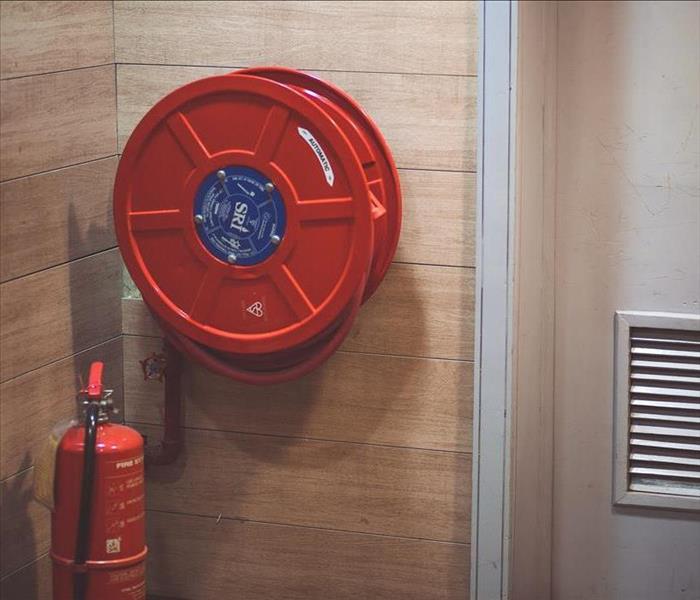 Having proper equipment to prevent fires is important.
Having proper equipment to prevent fires is important.
Studies have shown that most business fires occur while the premises are not populated, between the hours of 7 pm and 7 am, causing a large amount of damage. Commercial fires, caused by cooking equipment, are also potentially devastating, but surprisingly, the most damaging ones start in an office environment! Here are some fire prevention tips to help lower the odds your office is affected by fire.
Have A Plan. Designating someone as your “safety officer” is one step you can take that will really help. He or she can take the lead in establishing appropriate escape routes and meeting places, and setting up appropriate emergency procedures, as well. Your employees should be aware that the safety officer is in charge during any emergency and will be the one responsible for contacting emergency personnel, keeping track of employees, and assisting with providing information on equipment and chemicals kept in your office. An up-to-date emergency contact list should always be available at your place of business, and you should designate someone to be in charge of contacting family members or next-of-kin, in case of injury or a missing person.
Have Proper Equipment. There are specific items you will need to have on hand in advance of a fire, such as fire extinguishers and smoke alarms, and these are required through local building codes, so they should be present. Alarms and extinguishers need to be inspected monthly and replaced when necessary. You will also want to have a fully-stocked first aid kit and bottled water on hand, as well as flashlights, just in case.
Hold Regular Drills. Your safety officer should schedule regular drills and training to make sure everyone is well-versed in what to do in case of an emergency, such as an office fire. During these drills, new emergency response information can be shared to keep everyone up to date.
Follow these Preventive Tips to prevent a fire in the first place:
- Follow manufacturers’ recommendations for maximum volt/wattage load for surge protectors, power strips and adapters, and ask your electrician to periodically inspect these items and outlets for potential overload.
- Replace frayed power cords and never run them under rugs or carpeting. Use cord protectors, instead.
- Unplug appliances (coffeemakers, microwaves) and other equipment not in use at the end of the day and over the weekend.
- Replace appliances that feel warm or hot to touch.
- Ask the fire marshal to inspect chemical and equipment storage areas periodically to ensure proper ventilation and stowage.
- Store hazardous materials according to manufacturers’ instructions and OSHA regulations. Clearly mark these items to help emergency personnel identify and stabilize them.
- Don’t prop fire doors open or block exits with furniture or boxes.
- Don’t allow paper and other trash to accumulate outside of garbage or recycling receptacles, and never store this material near hot equipment, electrical outlets or the smoking areas.
- Don’t permit employees to burn candles, scented oils, etc. in their personal work areas.
Our SERVPRO of South and North West Grand Rapids team is here to help you in the event of damage from fire or water. We’re available 24 hours a day, 7 days a week, and we are mold prevention and remediation specialists, too!
PLAN AHEAD Southwest Grand Rapids: May is Wildfire Community Preparedness Day
5/1/2018 (Permalink)
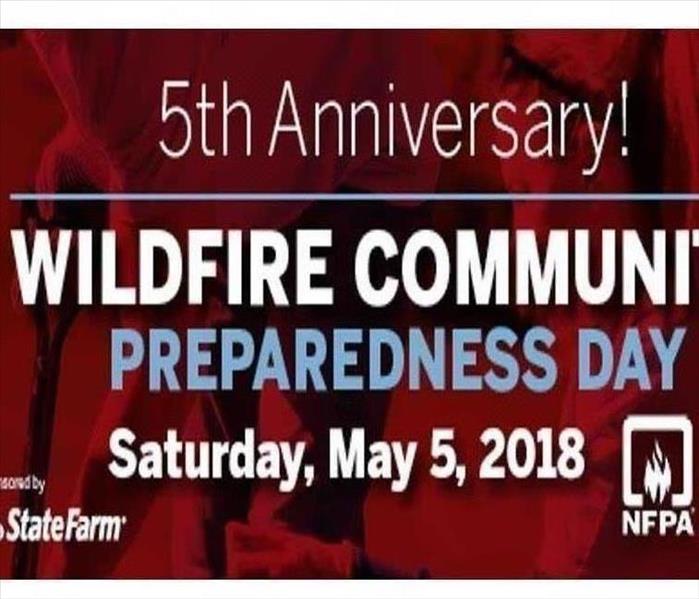 Wildfires happen! Join together to prevent with them.
Wildfires happen! Join together to prevent with them.
In 2017, there were 66,131 wildfires in the U.S., which burned 9.7 million acres, according to National Centers for Environment Information (NOAA).
Help reduce your community’s wildfire risk by participating in a local event for Wildfire Community Preparedness Day. To see a project map to locate local events, or for more information and resources to host your own event, visit wildfireprepday.org.
On Saturday, May 5, 2018 the NFPA celebrates national Wildfire Community Preparedness Day. At a time when wildfires are causing more damage to homes and businesses each year, Preparedness Day is a reminder that there are many things we can do to be prepared for wildfire. The event serves as means to inspire and encourage people of all ages to plan and participate in a risk reduction or wildfire preparedness activity that makes there community a safer place to live.
If a wildfire affects your home or business, contact SERVPRO® of Southwest Grand Rapids at 616-662-9700 today for 24-hour emergency service.
When you gather for dinner don't let fire ruin your supper
5/1/2018 (Permalink)
 When your following your favorite recipe to cook, follow this safety recipe as well. Stay SAFE!
When your following your favorite recipe to cook, follow this safety recipe as well. Stay SAFE!
Every year families gather to celebrate special occasions by preparing a delicious feast, but if you don’t practice safe cooking habits, your occasion could become hazardous very quickly. According to the National Fire Protection Association, cooking fires are the number one cause of home fires and home injuries. The leading cause of fires in the kitchen is unattended cooking. It is important to be alert to prevent cooking fires.
- Be on alert! If you are sleepy or have consumed alcohol don’t use the stove or stovetop.
- Stay in the kitchen while you are frying, grilling, boiling or broiling food.
- If you are simmering, baking or roasting food, check it regularly, remain in the kitchen while food is cooking, and use a timer to remind you that you are cooking.
- Keep anything that can catch fire—
- oven mitts
- wooden utensils
- food packaging
- towels or curtains—away from the stovetop.
If you have a cooking fire, consider the following safety protocols to help keep you and your family safe.
- Just get out! When you leave, close the door behind you to help contain the fire.
- Call 9-1-1 or the local emergency number after you leave.
- For an oven fire turn off the heat and keep the door closed.
- If you try to fight the fire, be sure others are getting out and you have a clear way out.
- Keep a lid nearby when you’re cooking to smother small grease fires. Smother the fire by sliding the lid over the pan and turn off the stovetop. Leave the pan covered until it is completely cooled.
SERVPRO® of Southwest Grand Rapids Professionals wish you a safe and happy family gathering.
Southwest Grand Rapids BBQ Hazards to avoid
5/1/2018 (Permalink)
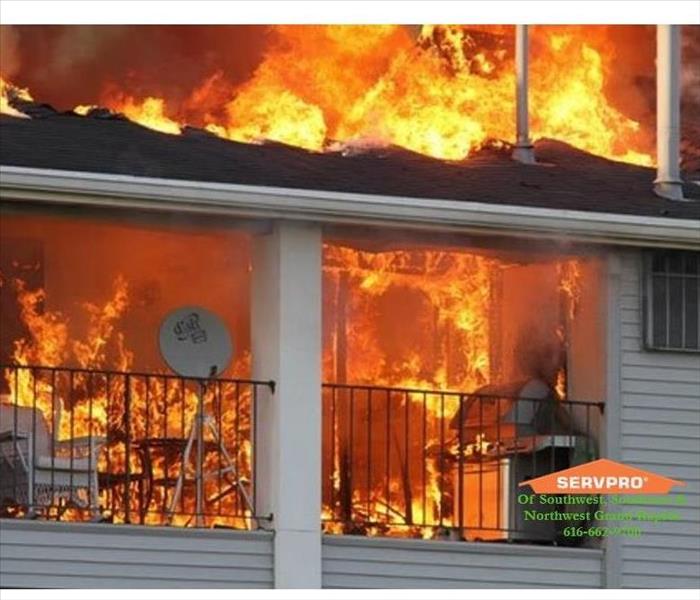 Keep your grill at least 10 feet from any structure.
Keep your grill at least 10 feet from any structure.
Summer is synonymous with barbecues, parades and fireworks displays; but along with all the festivities are plenty of visits to emergency rooms, especially during July. Each year, an average of 230 people are injured badly enough to require medical treatment after fireworks-related incidents, according to the U.S. Consumer
Product Safety Commission. In addition to causing injury, fireworks are also responsible for thousands of house fires each year with millions of dollars in property damage.
There is nothing like firing up the grill during the summer months! Did you know, July is the peak month for grill fires? A backyard barbecue can become dangerous if safety precautions aren’t considered. SERVPRO® of Southwest Grand Rapids want you to have an enjoyable and safe summer. Consider the following tips to ensure your summer celebrations are disaster-free!
- Propane and charcoal BBQ grills should only be used outdoors.
- The grill should be placed away from the home, deck railings and out from under eaves and overhanging branches.
- Keep children and pets away from grill area.
- Keep your grill clean by removing grease or fat buildup from the grills and in trays below the grill. Never leave your grill unattended.
- When using a charcoal grill, let the coals completely cool before disposing in a metal container.
- Anyone using fireworks or standing nearby should wear protective eyewear.
- Do not try to re-light or handle malfunctioning fireworks.
- Keep a bucket of water nearby to fully extinguish fireworks that don’t go off or in case of fire.
- Children should never pick up left over fireworks as they may still be active.
- The safest way to enjoy fireworks is to attend a public display conducted by trained professionals.
If you are affected by a fire contact SERVPRO® of Southwest Grand Rapids at 616-662-9700 for emergency services for your home or business.
The Importance of Cleaning Dryer Vents to prevent fires
5/1/2018 (Permalink)
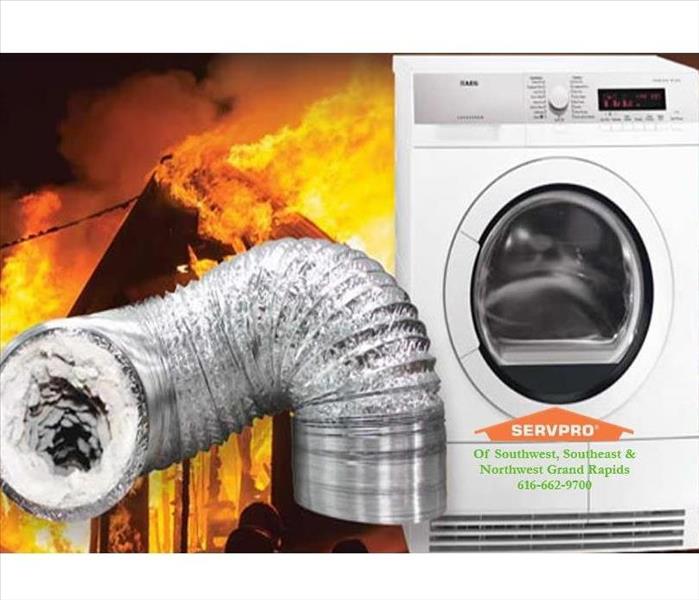 Don't let lint ruin your home!
Don't let lint ruin your home!
How often do you clean your dryer vent? Is this something you think about when you do your annual spring cleaning? Dryer lint is a great resource to save in a container to make fire starters for camping or outdoor fires. However it can wreak havoc in your home if you leave it in your dryer.
According to FEMA, failure to clean home dryers causes 34% of home dryer fires. Home dryer fires cause $35 million in property loss and can even cause injury or death.
To reduce the risk of these fires happening in your or your insured’s home or business ensure the following:
- Clean your Lint filter after every use
- Vacuum out the vent hose from the dryer
- Keep debris clear from around and under the dryer
- Keep vent flap clear of obstructions (such as: piled up lent, snow, a bird’s nest and potential obstacles)
For more information on cleaning dryer vents contact SERVPRO® of Southwest Grand Rapids at 616-662-9700 today.
Destroy Odors with DEODORIZATION in Southwest Grand Rapids
5/1/2018 (Permalink)
 Let the professionals remove the odor from your home! We know how to attack source.
Let the professionals remove the odor from your home! We know how to attack source.
Even a small fire can cause odors for years to come if the affected areas are not properly cleaned and deodorized. Fire, smoke and soot damage in your home or business can create unpleasant and potentially permanent problems.
Other odors that may require deodorization:
- Cigarette Smoke
- Pet Odors
- Decomposition
- Mold
As various materials burn, the smoke produced travels throughout the structure, leaving odorous residues and deposits on surfaces and in hard-to-reach places. Unless fast, professional action is taken, these residues and deposits can cause permanent damage to contents and may result in resurfacing odors.
With technicians certified by the Institute of Inspection, Cleaning and Restoration (IICRC), SERVPRO® of Southwest Grand Rapids provides specialized services that can rid your home or business of offensive odors left by fire or smoke damage. Our technicians do not cover up lingering odors with a fragrance; they seek out and remove the sources of the odor. Once the source is found, SERVPRO® own proprietary line of cleaning products is used to treat and prevent the odor from returning. Any restorable item in affected areas will also be professionally cleaned and deodorized, including furniture, draperies and upholstery, electronics, art, flooring, walls, ceilings, HVAC air ducts, and more.
Our trained professional will explain the various deodorization methods available and which will work best for you.
If you or a neighbor suffer a fire damage or some other accident and require deodorization services, contact SERVPRO® of Southwest Grand Rapids at 616-662-9700 today for 24-hour service. Whether it’s fire, water, or mold damage, or just a stubborn odor that refuses to go away, we’ll help make it “Like it never even happened.”
Smoke Alarms
3/30/2018 (Permalink)
 Test every month, change battery every year and replace every 10 years.
Test every month, change battery every year and replace every 10 years.
Smoke alarms save lives when properly installed and maintained, according to the National Fire Protection Association (NFPA).
In homes, smoke alarms should be in every bedroom, outside each sleeping area, and on every level, including the basement. Extra smoke alarms may be needed in large homes.
Test smoke alarms monthly using the test button. Smoke alarms with non-replaceable batteries need the entire smoke alarm unit replaced every ten years. Other alarms need batteries replaced every year, and the unit replaced every ten years. If the alarm chirps signaling low battery, take the proper steps to replace the unit or the batteries immediately. Never disable or remove the battery from an alarm. Almost half of fires where smoke alarms were present but did not activate had missing or disconnected batteries (NFPA).
If you need help installing, testing or changing batteries in your smoke alarms, contact your local fire department, an electrician or the American Red Cross.
Be sure your home has a fire emergency plan in place and conduct regular fire drills with your family. For more information on Emergency Preparedness, contact SERVPRO® of Southwest Grand Rapids Professional at 616-662-9700.
FIRE FACTS
* 7 People die every day from a home fire.
* 36 People suffer injuries as a result of home fires every day.
* $7 BILLION in property damage occurs every year.
Portable Fire Extinguishers
3/5/2018 (Permalink)
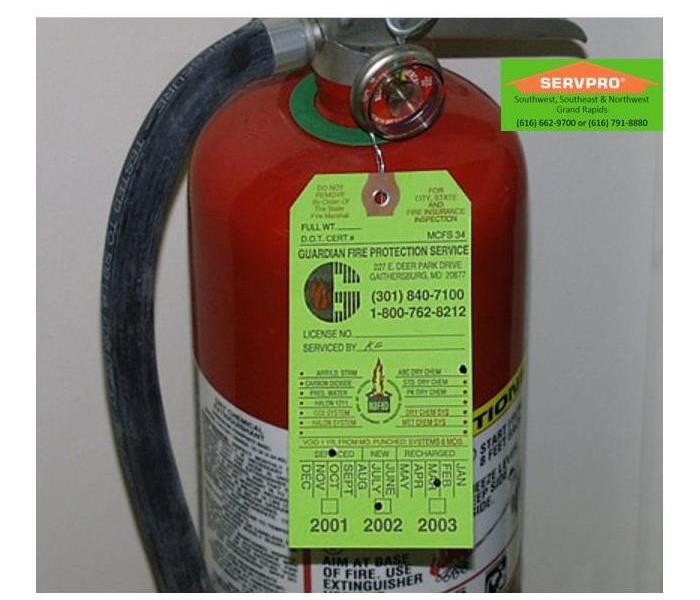 SERVPRO of Southwest Grand Rapids cleans up the mess after the extinguisher is dispensed.
SERVPRO of Southwest Grand Rapids cleans up the mess after the extinguisher is dispensed.
Portable fire extinguishers can be life and property saving tools when used correctly. Read the instructions on the fire extinguisher and become familiar with them before a fire breaks out. In order to operate an extinguisher, the National Fire Protection Association (NFPA) suggests remembering the word PASS:
Pull the pin. Hold the nozzle pointing away from you and release the locking mechanism.
Aim low. Point the extinguisher at the base of the fire.
Squeeze the lever slowly and evenly.
Sweep the nozzle from side-to-side.
Help people decide when to use a fire extinguisher
Fire extinguishers can be helpful on a small fire. Consider providing a checklist to help people prepare to use a fire extinguisher on a potential fire.
For example:
- Have I alerted others in the building that there’s a fire?
- Has someone called the fire department?
- Am I physically able to use a fire extinguisher?
- Is the fire small and contained in a single object (like a pan or a wastebasket)?
- Am I safe from the fire’s toxic smoke?
- Do I have a clear escape route?
- Use a fire extinguisher when all of these questions are answered “yes.” If you’re unsure about whether or not it’s safe to use a fire extinguisher, and for all other situations, alert others, leave the building, and call 911 from a mobile or neighbor’s phone. It is not recommended that children use fire extinguishers.
Visit US Fire Administration for more information on Choosing and using Fire extinguishers.
Southwest Grand Rapids, Smoke and Soot Cleanup
3/21/2017 (Permalink)
Smoke and soot is very invasive and can penetrate various cavities within your home, causing hidden damage and odor. Our smoke damage expertise and experience allows us to inspect and accurately assess the extent of the damage to develop a comprehensive plan of action.
Smoke and soot facts:
- Hot smoke migrates to cooler areas and upper levels of a structure.
- Smoke flows around plumbing systems, seeping through the holes used by pipes to go from floor to floor.
- The type of smoke may greatly affect the restoration process.
Different Types of Smoke
There are two different types of smoke–wet and dry. As a result, there are different types of soot residue after a fire. Before restoration begins, SERVPRO of Southwest Grand Rapids, will test the soot to determine which type of smoke damage occurred. The cleaning procedures will then be based on the information identified during pretesting. Here is some additional information:
Wet Smoke – Plastic and Rubber
- Low heat, smoldering, pungent odor, sticky, smeary. Smoke webs are more difficult to clean.
Dry Smoke – Paper and Wood
- Fast burning, high temperatures, heat rises therefore smoke rises.
Protein Fire Residue – Produced by evaporation of material rather than from a fire
- Virtually invisible, discolors paints and varnishes, extreme pungent odor.
Our Fire Damage Restoration Services
Since each smoke and fire damage situation is a little different, each one requires a unique solution tailored for the specific conditions. We have the equipment, expertise, and experience to restore your fire and smoke damage. We will also treat your family with empathy and respect and your property with care.
Have Questions about Fire, Smoke, or Soot Damage?
Call Us Today – 616-662-9700




 24/7 Emergency Service
24/7 Emergency Service
